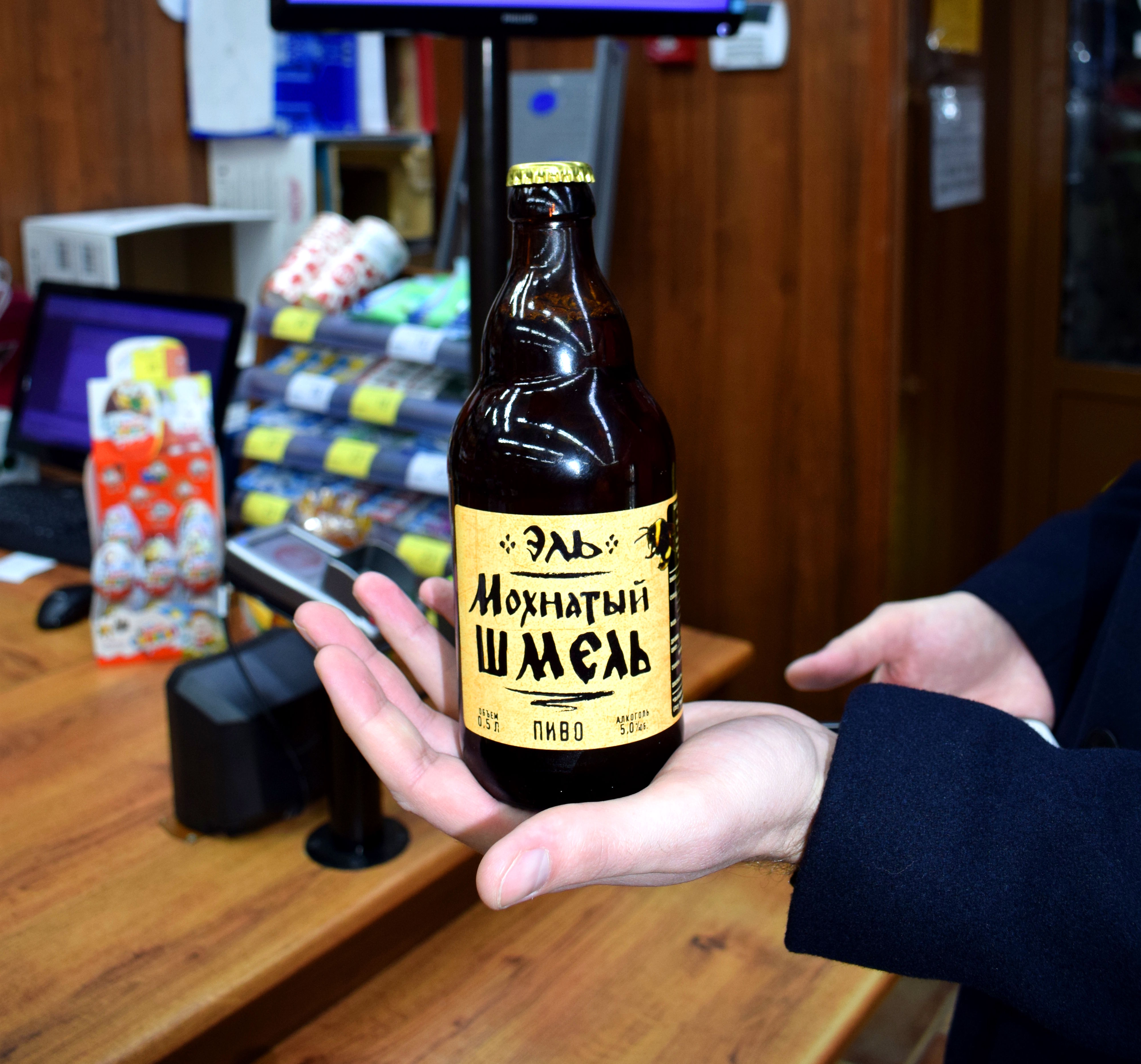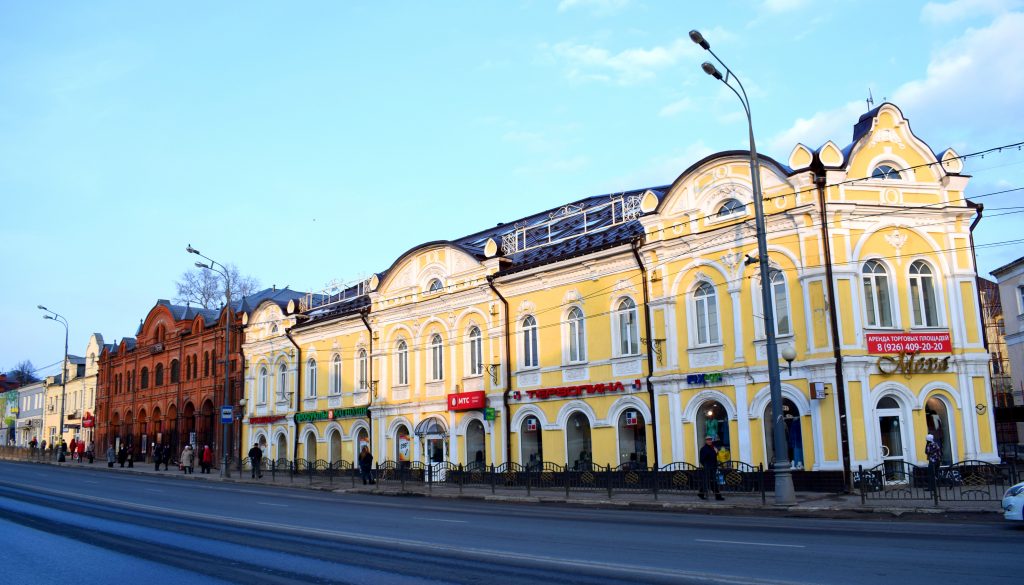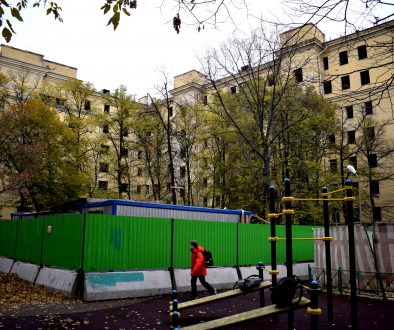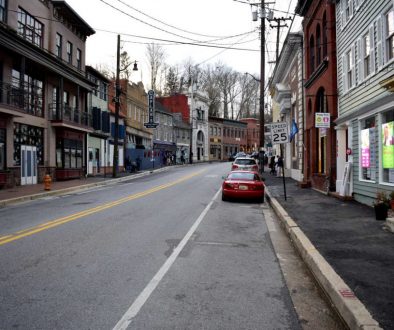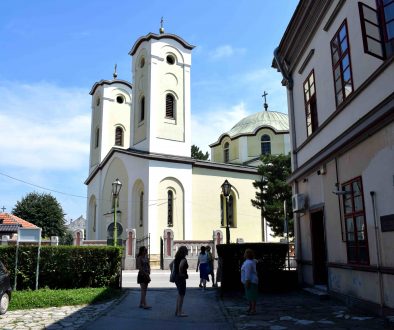Sergiev Posad is the next destination on our tour exploring historical towns around Moscow you can visit in a day.
Sergiev Posad is one of Russia’s oldest cities founded in the 14th century. It is also a Golden Ring city in Russia, which are a series of towns northeast of Moscow which form the ancient core of medieval Russia and which have seen a lot of their historic architecture preserved to this day.
You would think that the further west you go in Russia toward Europe, the more European the towns get, but that isn’t quite the case. In fact, because Russia suffered numerous invasions from Europe over the course of the centuries, beginning with the Poles and Swedes, the French in the 19th century and the Germans in the 20th century, most of the cities that lie west of Moscow suffered repeated destruction.
In contrast, towns east of Moscow have largely been preserved. The last true invader to attack Russia from the east were the Mongolians under Genghis Khan. Since then, these cities have remained untouched and miraculously survived Soviet attempts to wipe out religion in Russia in the 1930’s.
Sergiev Posad is one of those cities.
The easiest way to get to Sergiev Posad is to take a train from Moscow’s Yaroslavsky Station. Trains leave every 10-20 minutes. The ride costs 176 rubles in one direction, or about $3. The city is located 67 kilometers away and it takes 1.5 hours to get there.
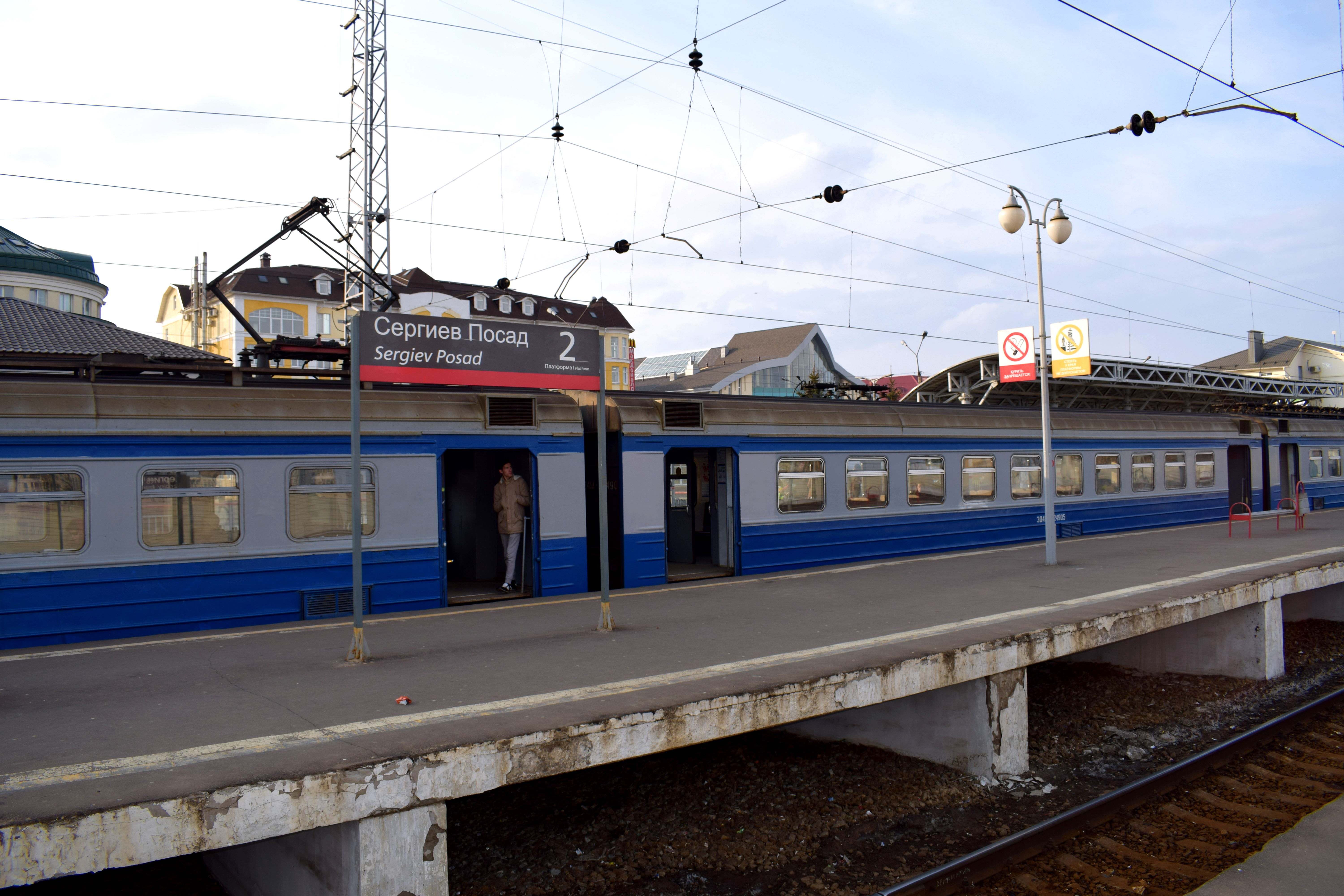 I always like to judge cities based on how easily accessible their centers are from the train station. Sergiev Posad’s train station had a decent location. The city center was only a 15 minute walk away and there were some historical buildings on the way.
I always like to judge cities based on how easily accessible their centers are from the train station. Sergiev Posad’s train station had a decent location. The city center was only a 15 minute walk away and there were some historical buildings on the way.
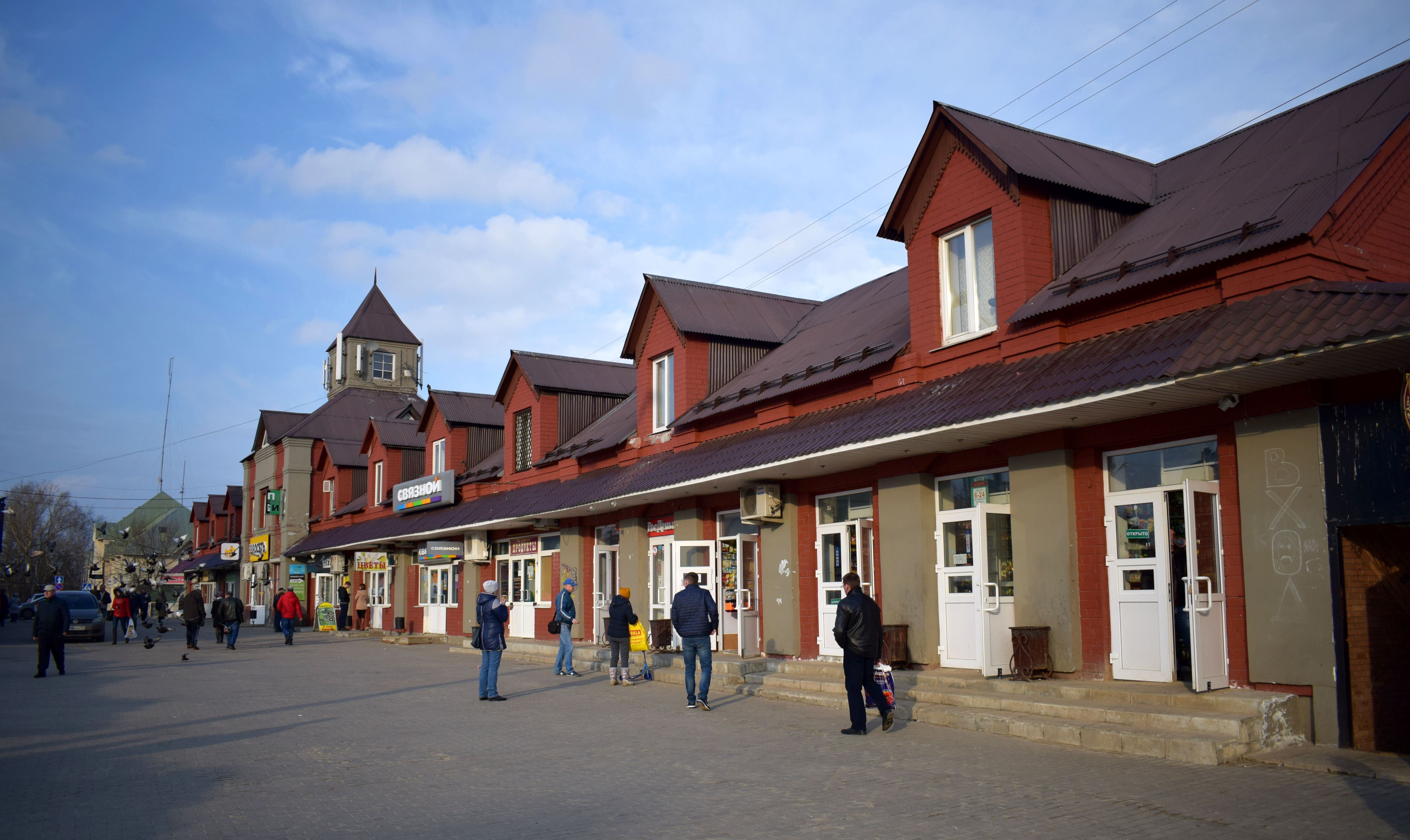 Of course like a lot of Russian cities, the city decided to locate its bus station right next to its train station. So despite having nice buildings, they were ruined by the ‘marshutkas’, or shuttle buses, that dominate smaller Russian cities. Sooner or later, Russian cities should get rid of these marshutkas and invest in proper buses or trams.
Of course like a lot of Russian cities, the city decided to locate its bus station right next to its train station. So despite having nice buildings, they were ruined by the ‘marshutkas’, or shuttle buses, that dominate smaller Russian cities. Sooner or later, Russian cities should get rid of these marshutkas and invest in proper buses or trams.
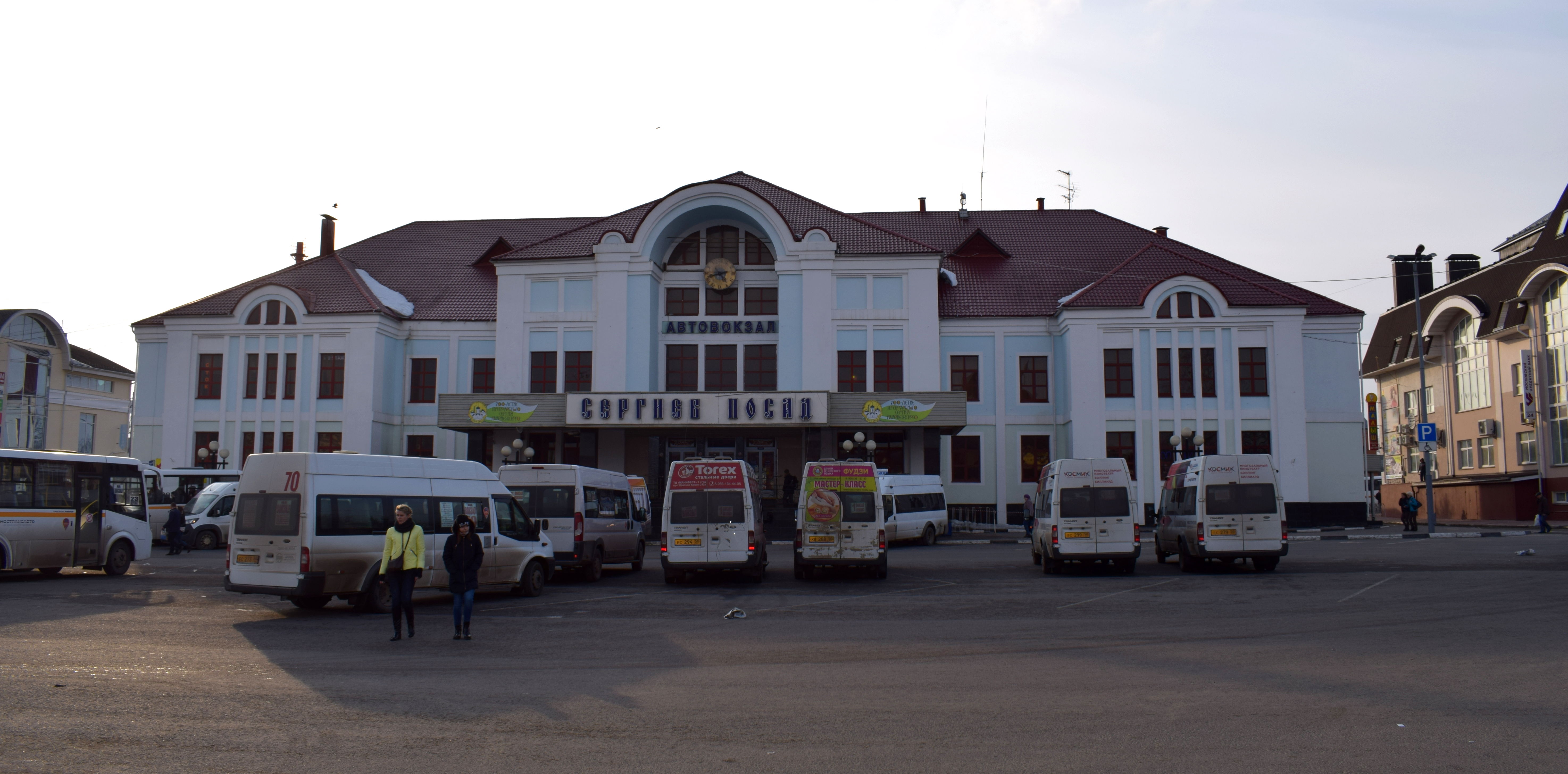 Walking toward Sergiev Posad’s city center.
Walking toward Sergiev Posad’s city center.
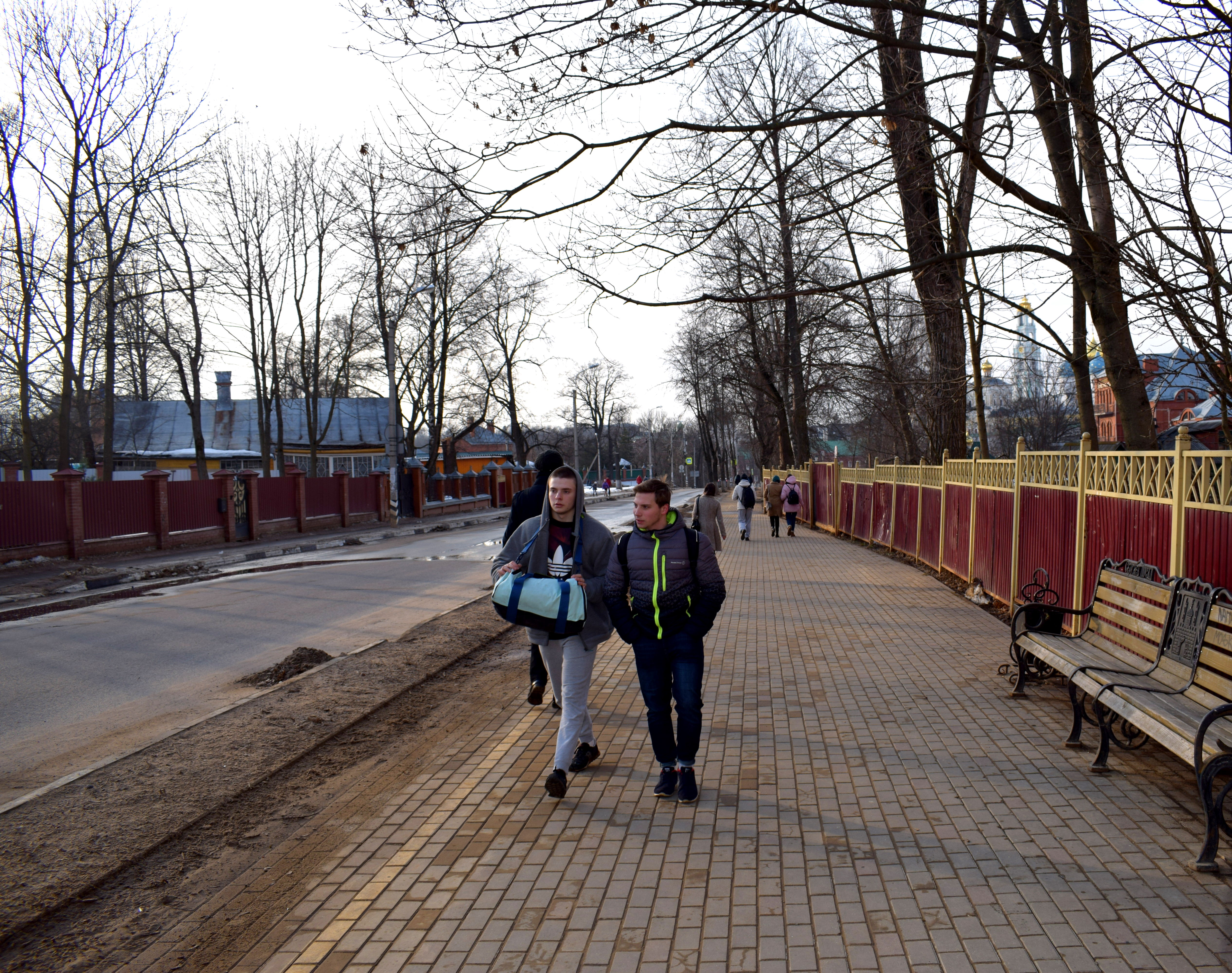 March is a wildcard month in Russia in terms of weather. Whereas in most other countries March signifies the start of spring, in Russia March is completely inconsistent. Often you will get a week of warm spring weather followed by a week of cold brutal winter and then back to spring. This kind of see-sawing usually continues for all of April and even in May.
March is a wildcard month in Russia in terms of weather. Whereas in most other countries March signifies the start of spring, in Russia March is completely inconsistent. Often you will get a week of warm spring weather followed by a week of cold brutal winter and then back to spring. This kind of see-sawing usually continues for all of April and even in May.
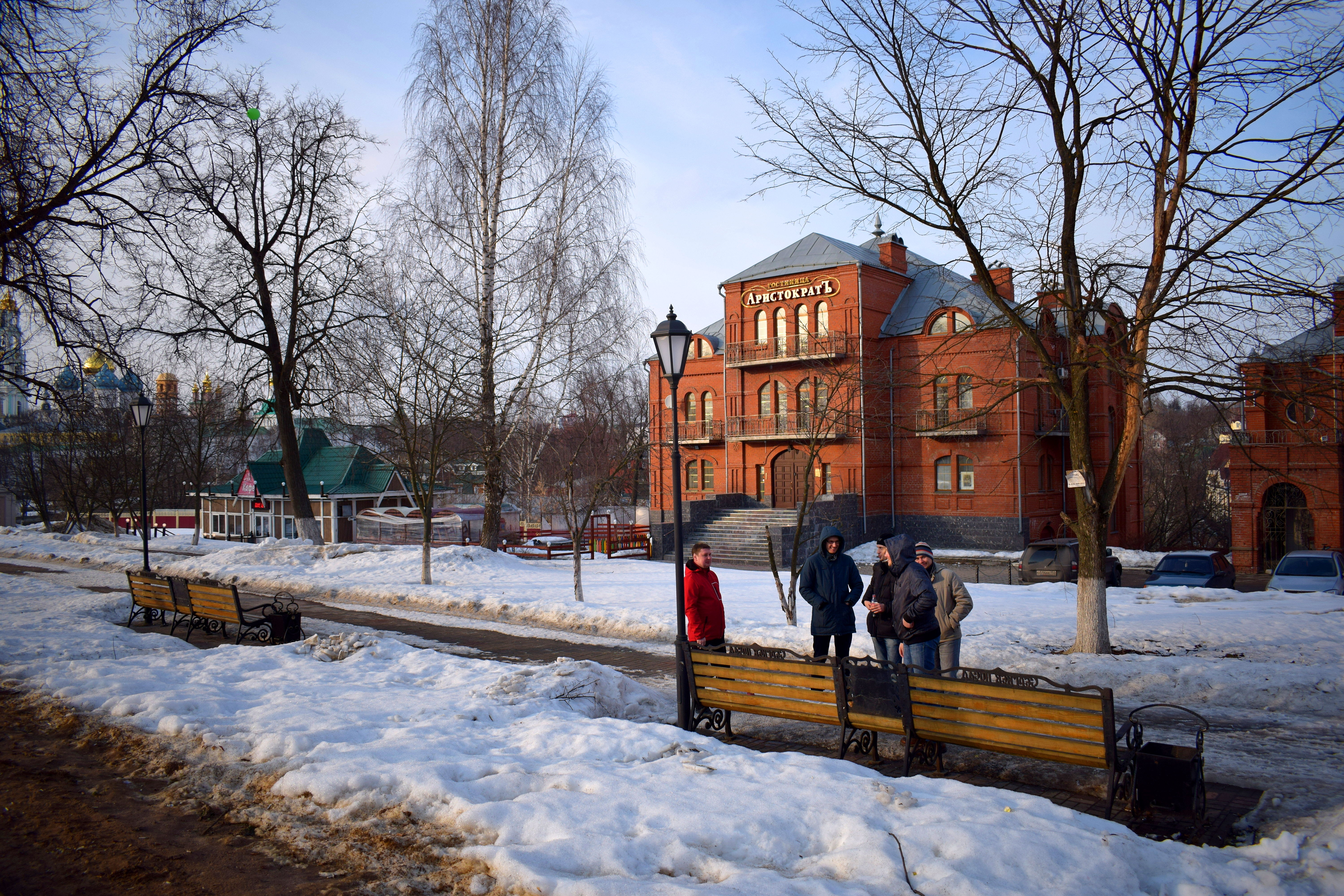 A panoramic view approaching Sergiev Posad. The city is most famous for the Trinity Lavra of St. Sergius Monastery, one of the oldest and biggest monasteries in all of Russia, founded in 1337 by St. Sergei of Radonezh.
A panoramic view approaching Sergiev Posad. The city is most famous for the Trinity Lavra of St. Sergius Monastery, one of the oldest and biggest monasteries in all of Russia, founded in 1337 by St. Sergei of Radonezh.
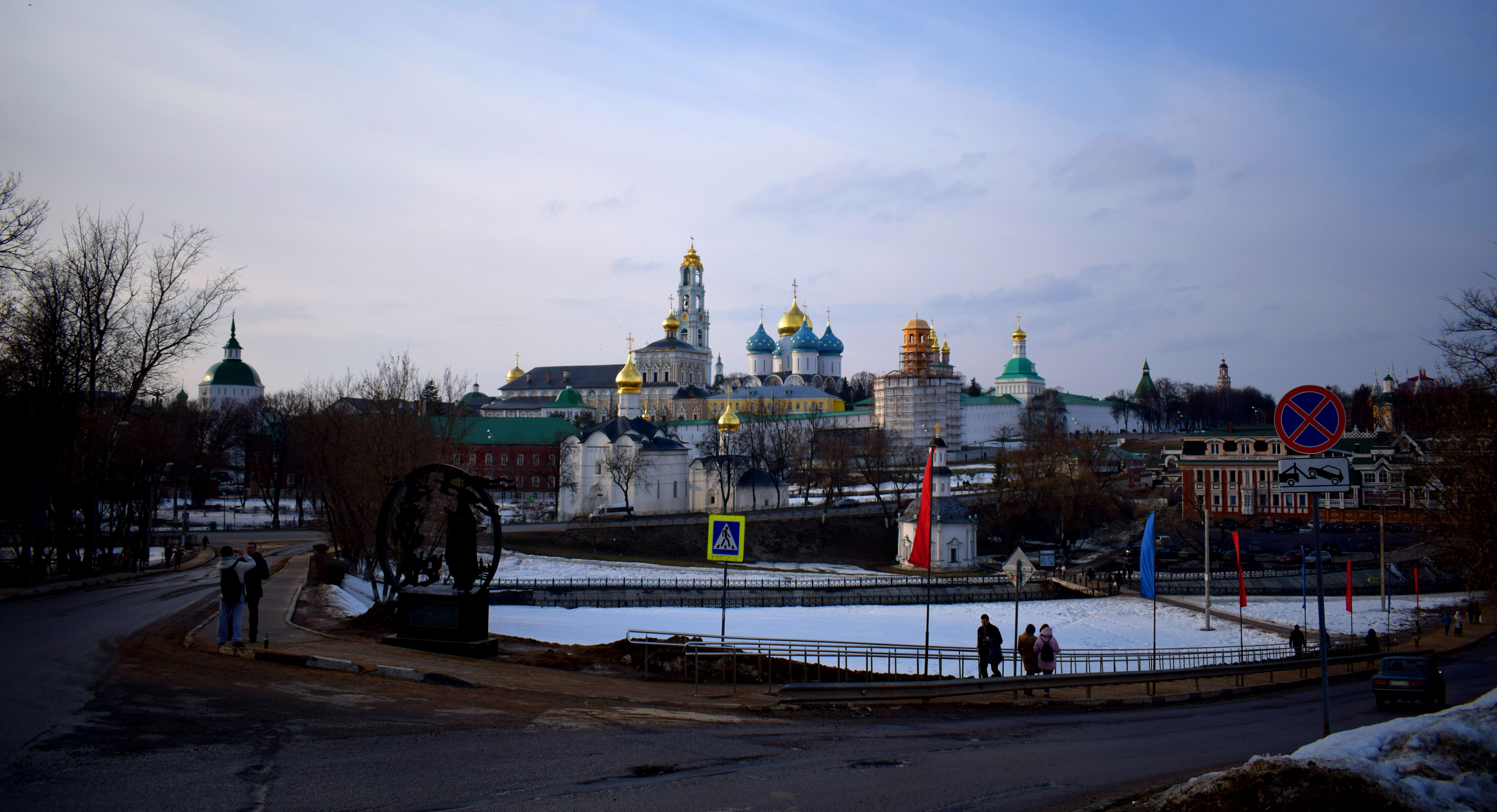 Near the entrance to the town is a monument celebrating the 700th anniversary of Sergiev Posad. The city got its name Sergiev Posad only in 1782 following a decree by Russian Empress Catherin II to name the city after the man who founded the monastery, St. Sergei of Radonezh. From 1930 to 1991 the city was renamed to Zagorsk after a famous communist leader. The city reverted back to its old name after the Soviet Union fell apart in 1991.
Near the entrance to the town is a monument celebrating the 700th anniversary of Sergiev Posad. The city got its name Sergiev Posad only in 1782 following a decree by Russian Empress Catherin II to name the city after the man who founded the monastery, St. Sergei of Radonezh. From 1930 to 1991 the city was renamed to Zagorsk after a famous communist leader. The city reverted back to its old name after the Soviet Union fell apart in 1991.
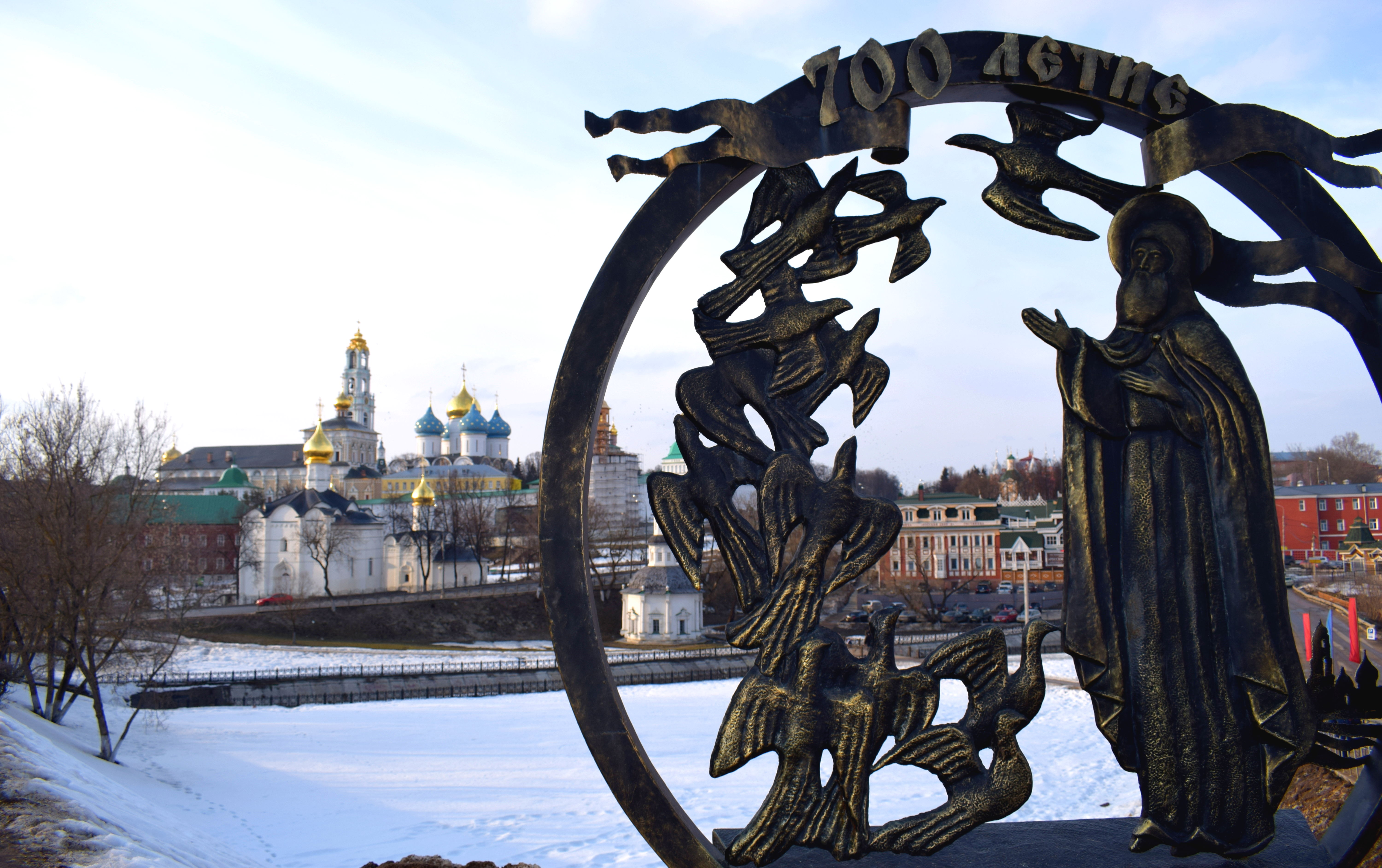 The best time to visit Sergiev Posad is in the summer. There are a number of lakes and small ponds sprinkled throughout the city around the monastery which were frozen over in March.
The best time to visit Sergiev Posad is in the summer. There are a number of lakes and small ponds sprinkled throughout the city around the monastery which were frozen over in March.
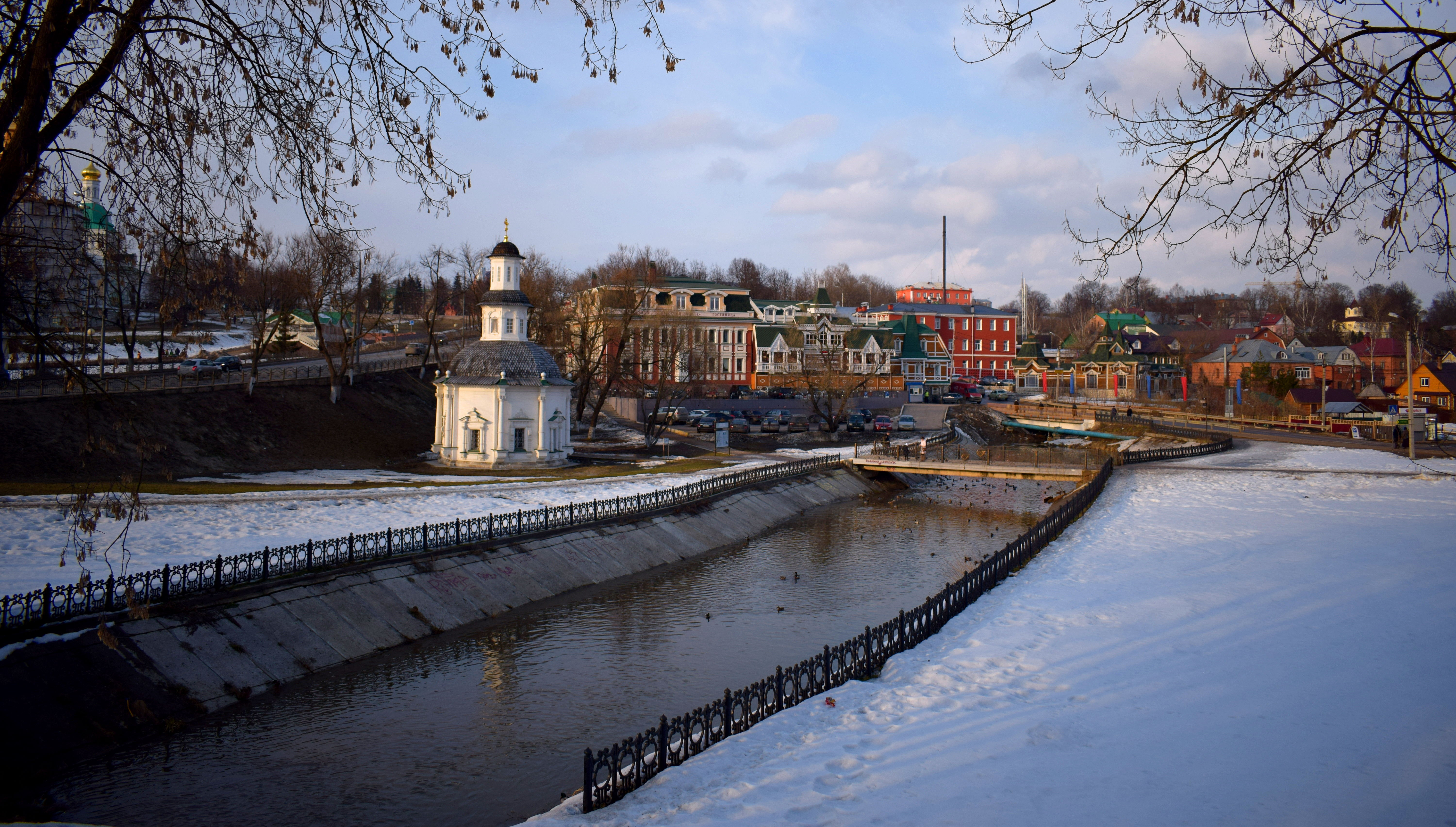 The Pyatnitsky Well Chapel, one of the early churches in the city built in the 1600’s.
The Pyatnitsky Well Chapel, one of the early churches in the city built in the 1600’s.
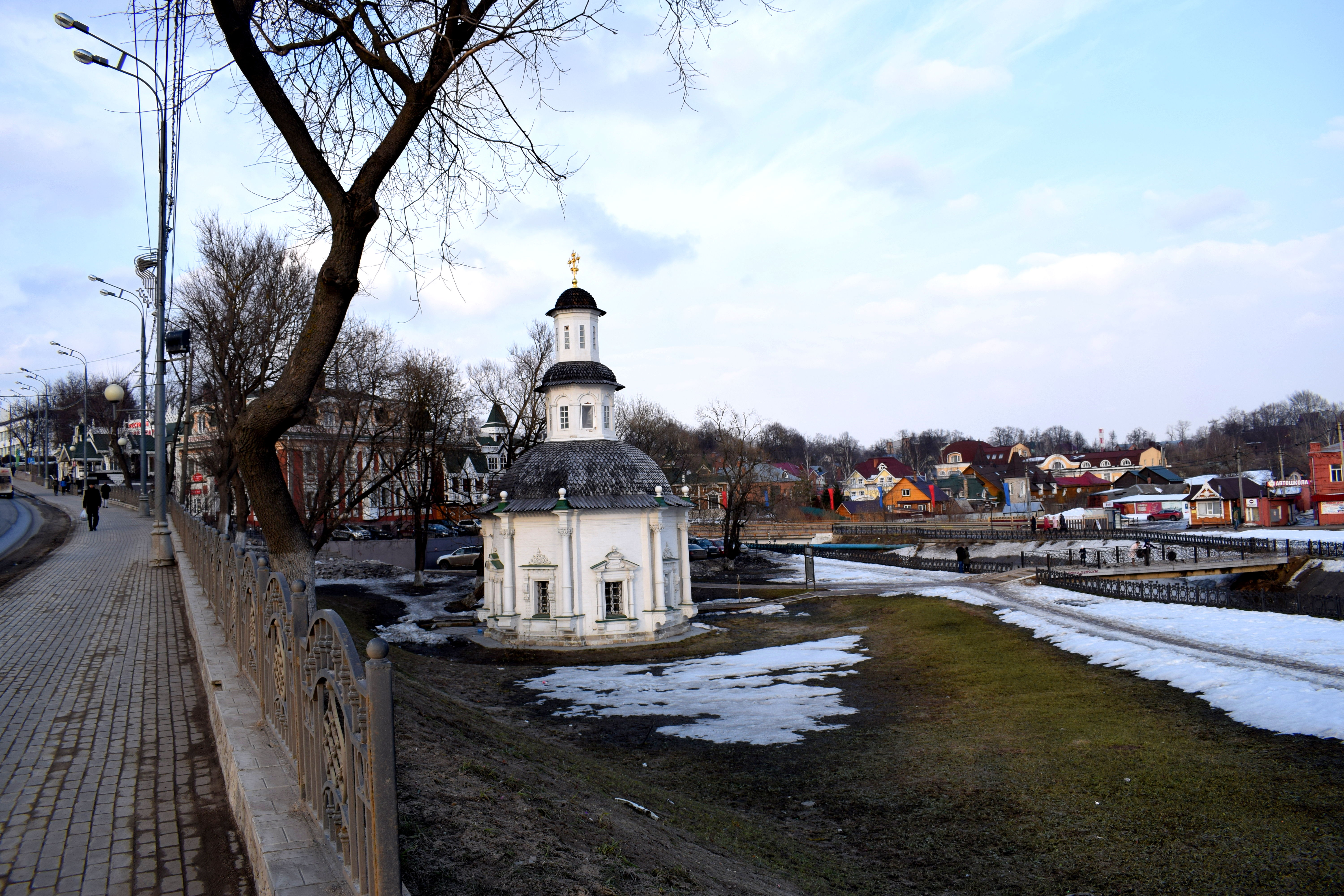 An other side of the street on the opposite side of the chapel is the Vvedenskaya Church, built in 1547. In was reconstructed in 1621 and again in 1740. In 1928 the Bolsheviks closed it down and it did not reopen as a church until after 1991.
An other side of the street on the opposite side of the chapel is the Vvedenskaya Church, built in 1547. In was reconstructed in 1621 and again in 1740. In 1928 the Bolsheviks closed it down and it did not reopen as a church until after 1991.
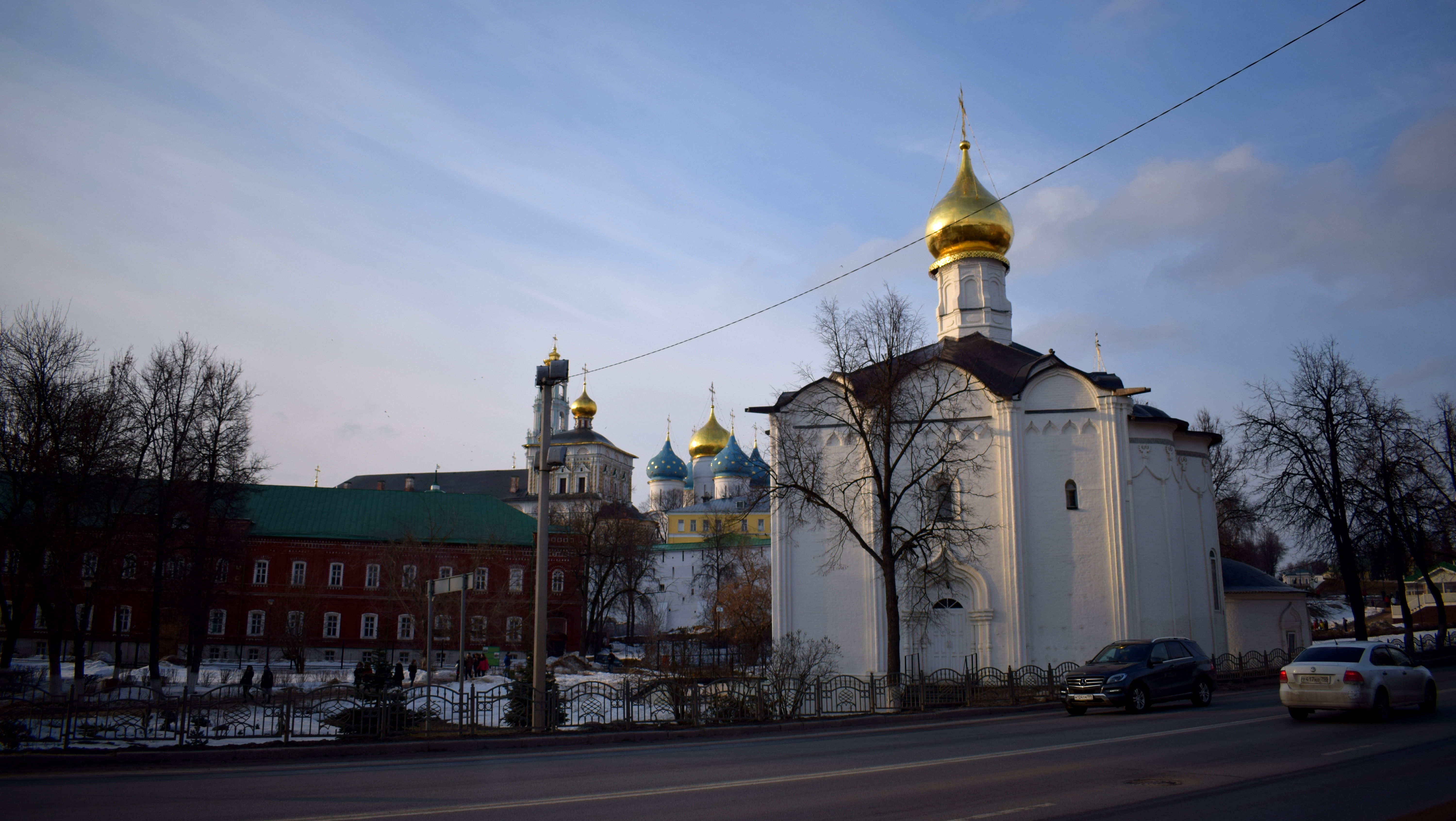
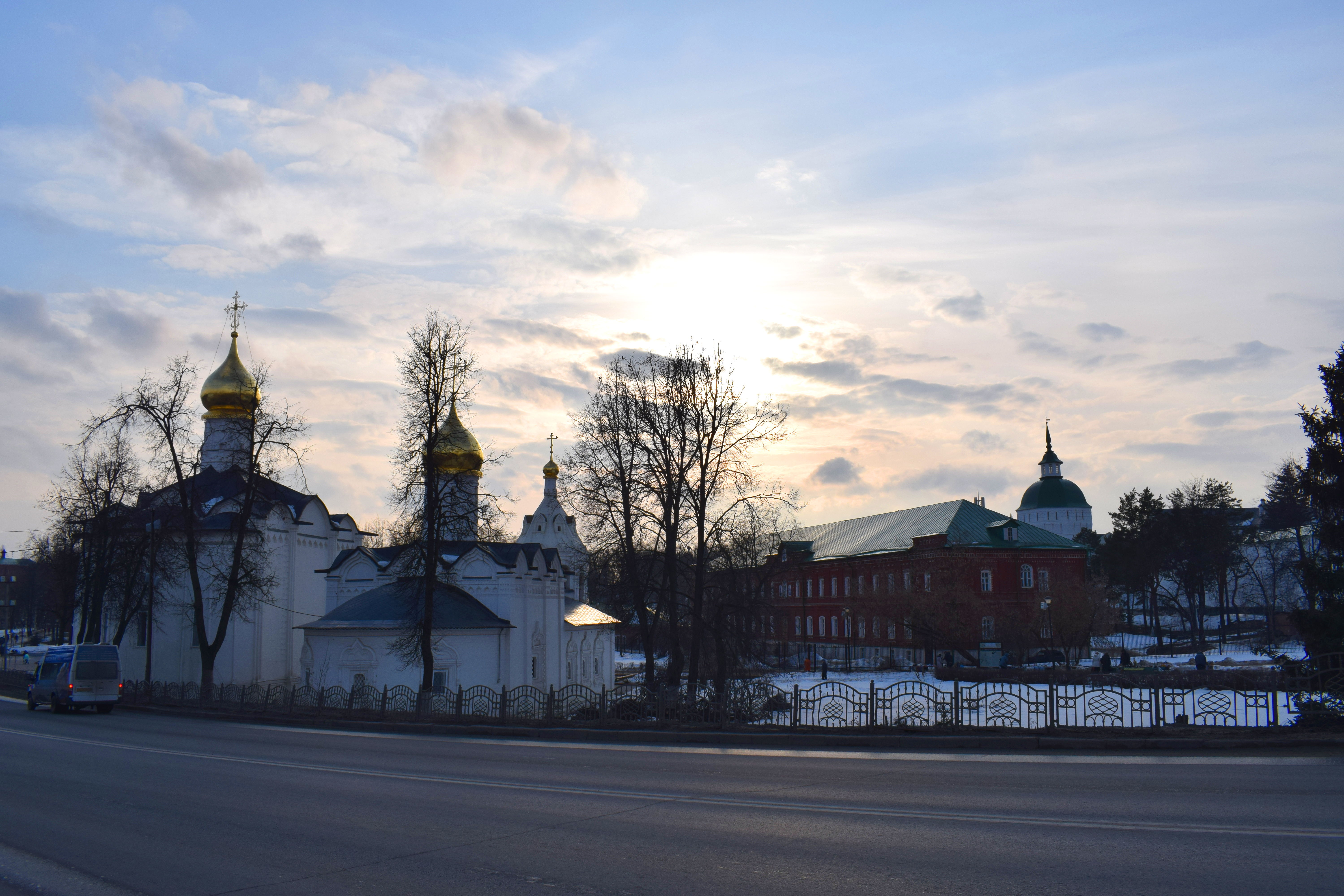 The Trinity Lavra of St. Sergius, Sergiev Posad’s main tourist attraction. One of the towers was being reconstructed when we visited.
The Trinity Lavra of St. Sergius, Sergiev Posad’s main tourist attraction. One of the towers was being reconstructed when we visited.
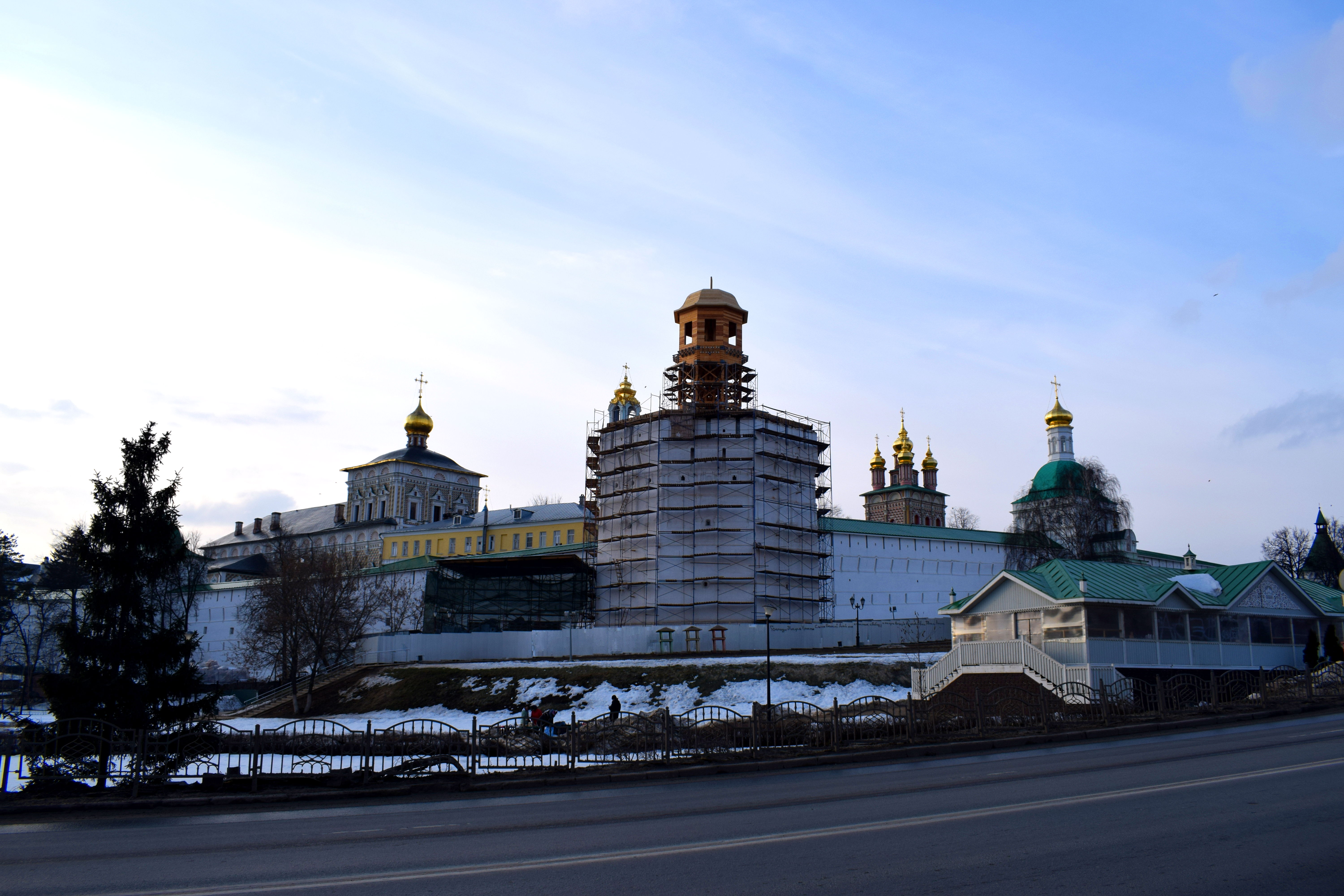 St. Sergius who founded the monastery was one of the most respected religious leaders in Russia during his time. He had over 4oo followers in Russia who would go on to found many other monasteries in northeastern Russia in the 14th century, including the Solovetsky, Kirillov and Simonov monasteries. St. Sergius was also an avid supporter of Dmitry Donskoi in his struggle with the Tatars, sending his monks to fight alongside the Russian leader during the Battle of Kulikovo in 1380.
St. Sergius who founded the monastery was one of the most respected religious leaders in Russia during his time. He had over 4oo followers in Russia who would go on to found many other monasteries in northeastern Russia in the 14th century, including the Solovetsky, Kirillov and Simonov monasteries. St. Sergius was also an avid supporter of Dmitry Donskoi in his struggle with the Tatars, sending his monks to fight alongside the Russian leader during the Battle of Kulikovo in 1380.
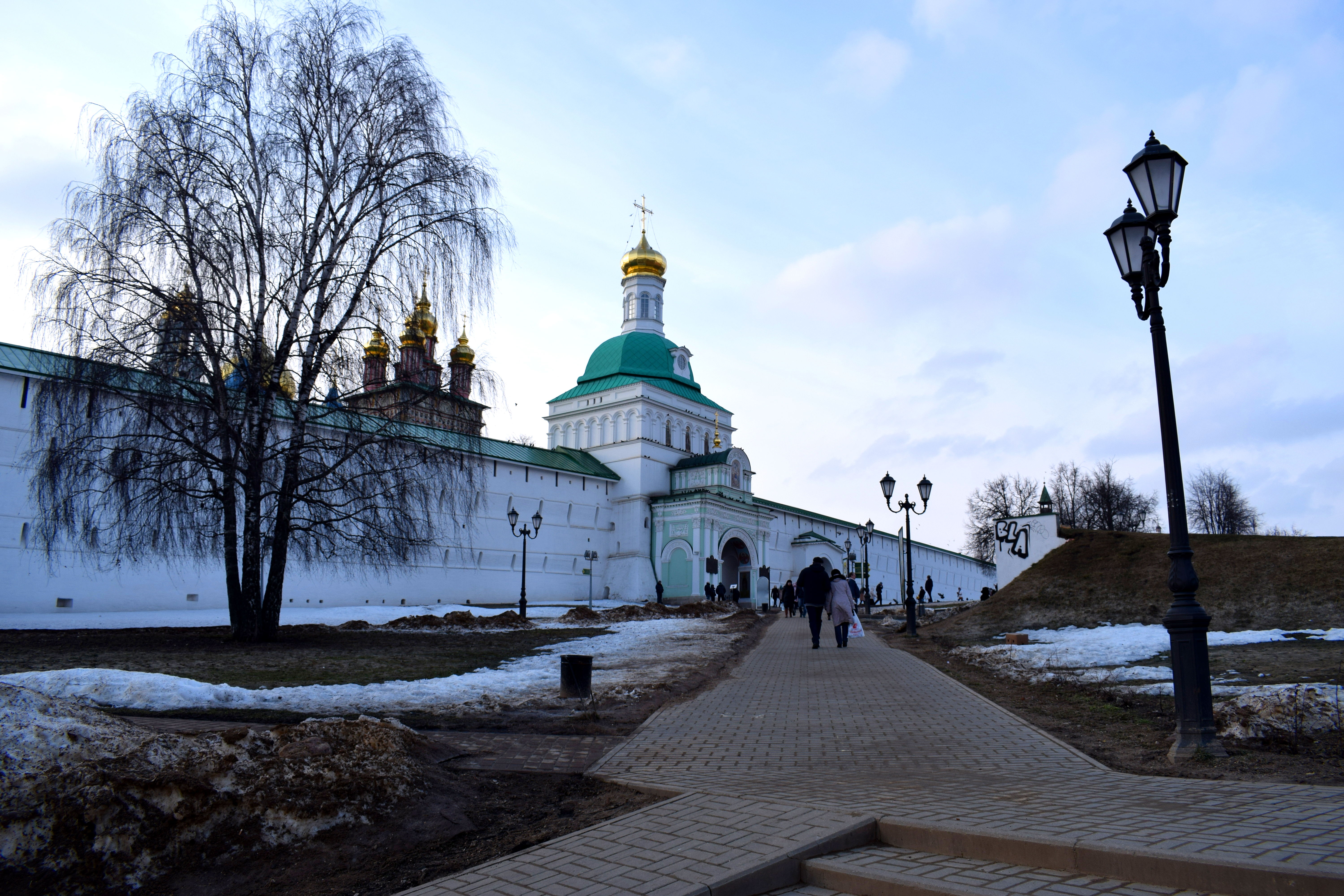 The square in front of the monastery. The red brick building was a famous merchant house built in the 1902-1903. Initially it was rented by the church to local tradesmen. When the Bolsheviks took over following WWI, the local administration was placed in the building. In 1920 a portion of the building burned down and its outward appearance was altered significantly when it was reconstructed.
The square in front of the monastery. The red brick building was a famous merchant house built in the 1902-1903. Initially it was rented by the church to local tradesmen. When the Bolsheviks took over following WWI, the local administration was placed in the building. In 1920 a portion of the building burned down and its outward appearance was altered significantly when it was reconstructed.
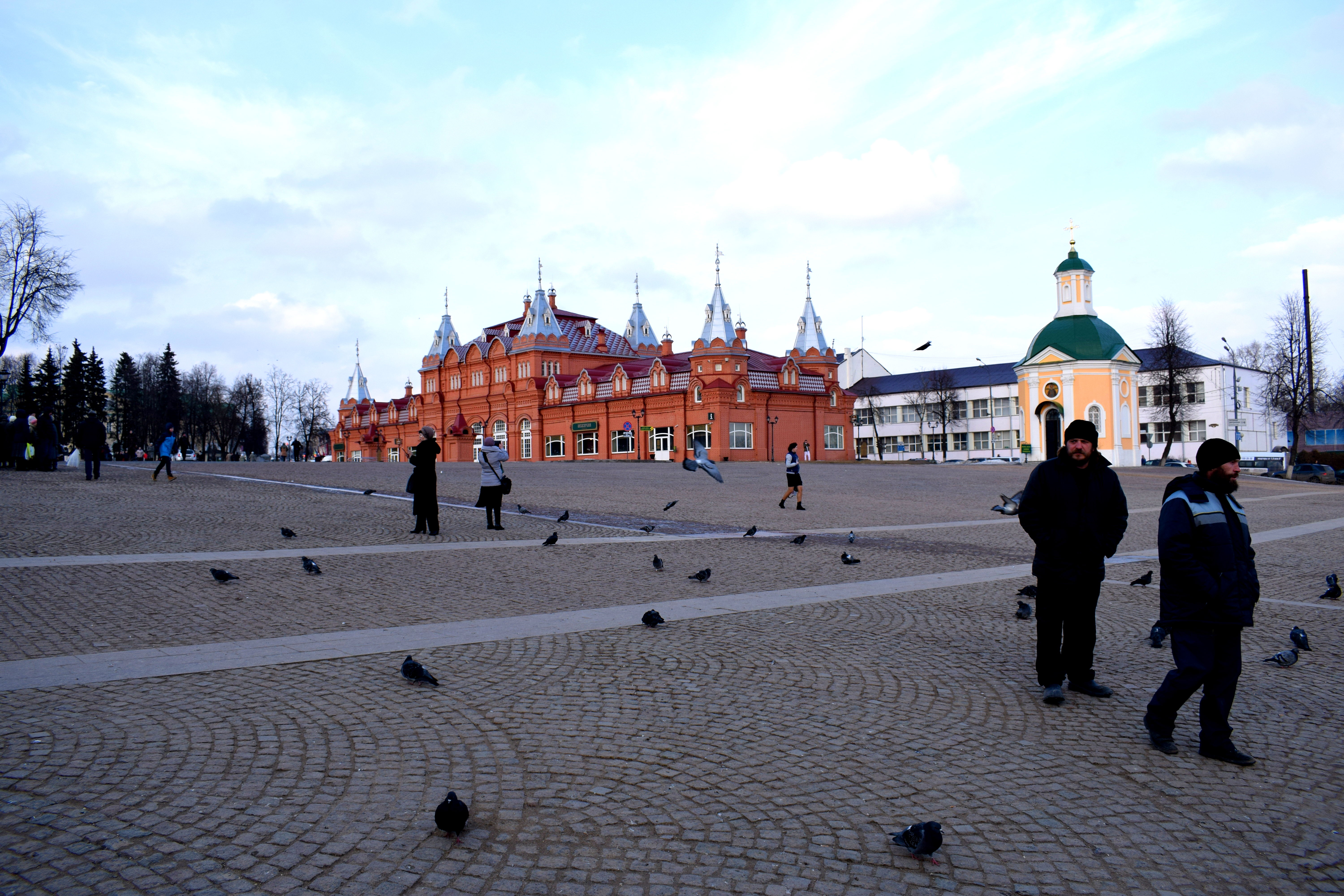 The walls of the monastery. Throughout the centuries these walls helped protect the monastery from repeated attacks from invaders. In 1408 the monastery was devastated by a fire after a Tatar unit attacked it. The biggest threat to the monastery would appear two centuries later during during a 16-month Polish-Lithuanian siege from 1608-1610. A Polish army of 15,000 attacked the monastery in the winter of 1908. Despite significantly outnumbering the Russian army of around 2,000, the Russians managed to hold back the Polish army which retreated to the town of Dmitriev afterward.
The walls of the monastery. Throughout the centuries these walls helped protect the monastery from repeated attacks from invaders. In 1408 the monastery was devastated by a fire after a Tatar unit attacked it. The biggest threat to the monastery would appear two centuries later during during a 16-month Polish-Lithuanian siege from 1608-1610. A Polish army of 15,000 attacked the monastery in the winter of 1908. Despite significantly outnumbering the Russian army of around 2,000, the Russians managed to hold back the Polish army which retreated to the town of Dmitriev afterward.
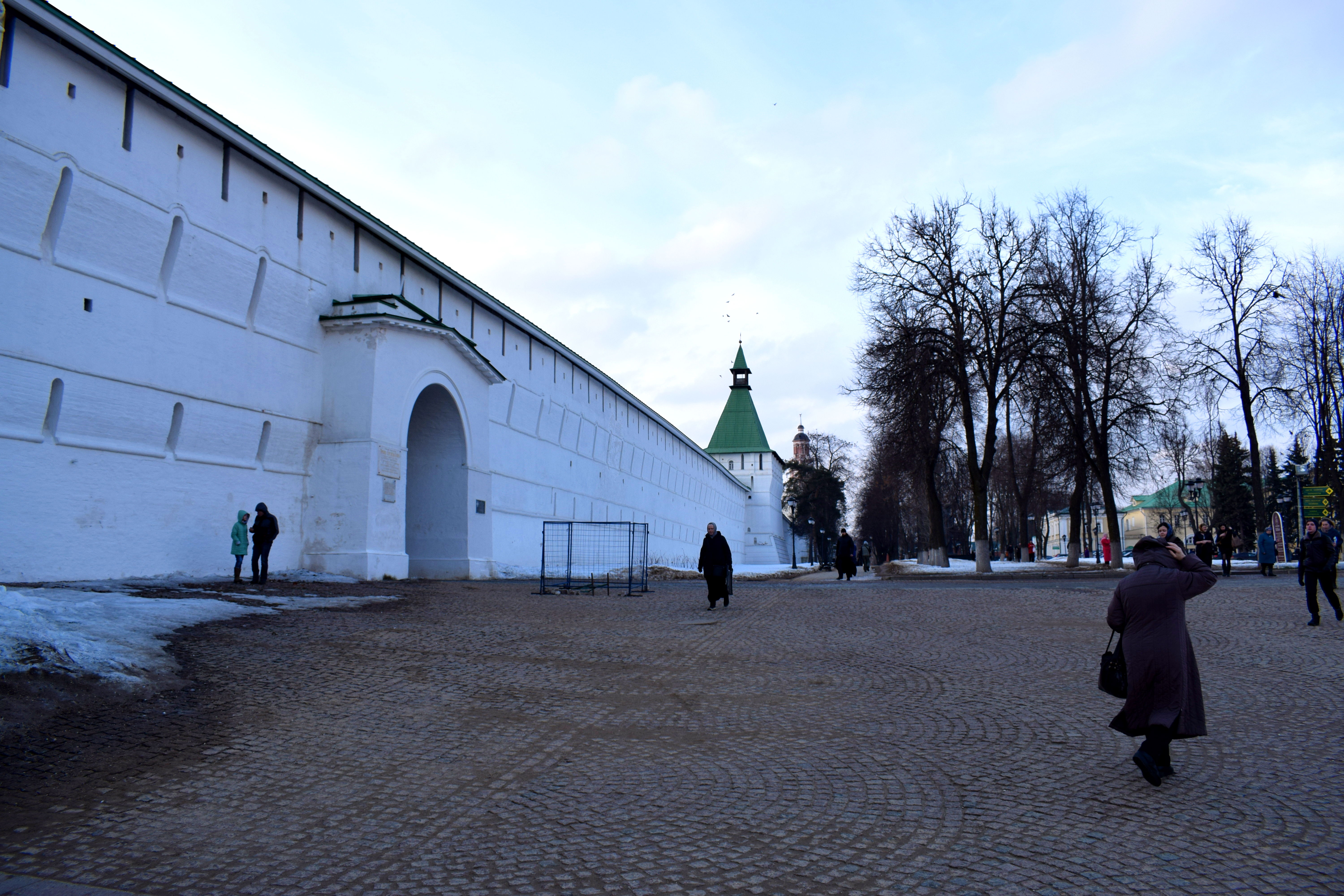 The entrance to the monastery.
The entrance to the monastery.
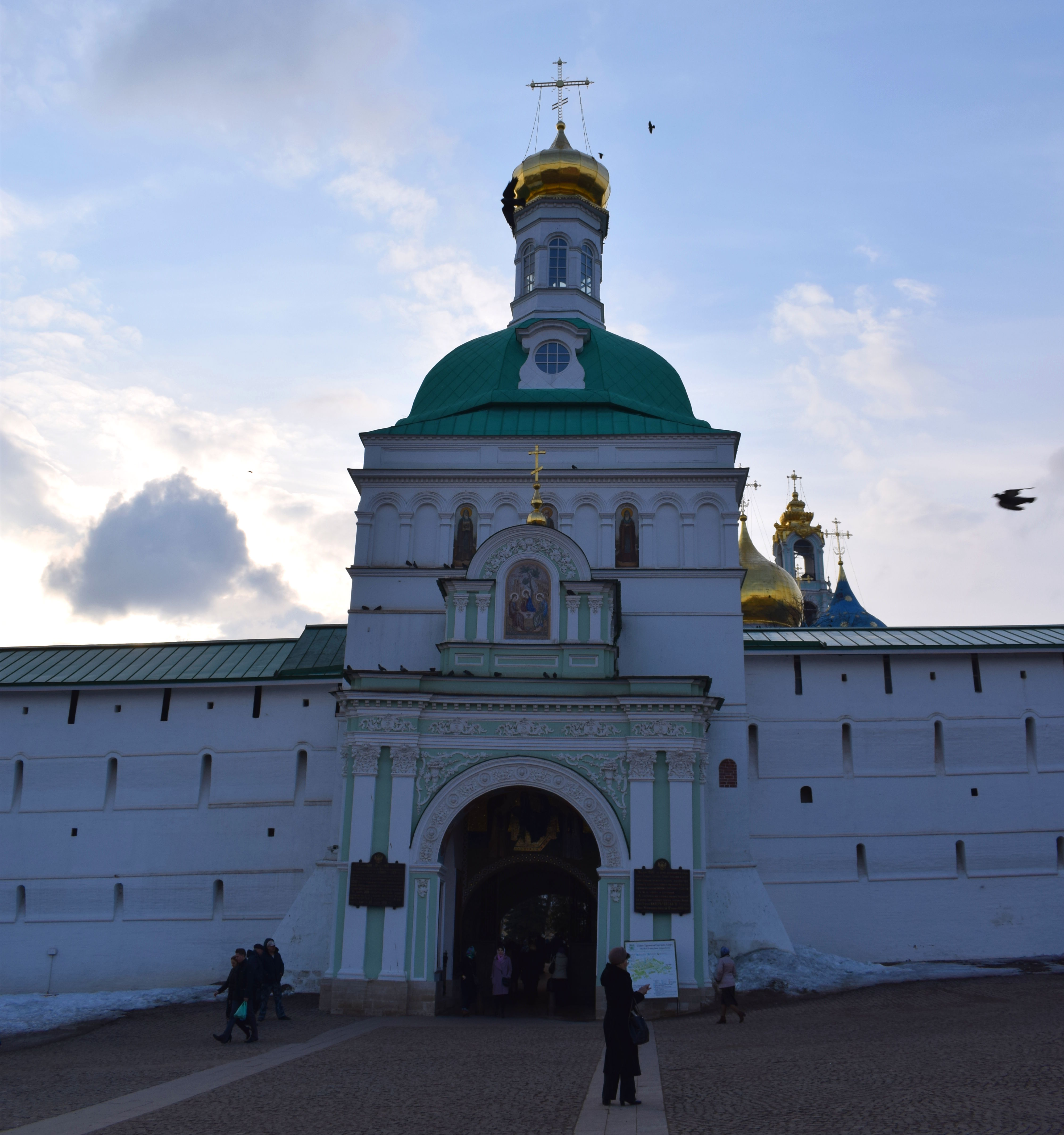 Beautiful murals line the walls of the entrance.
Beautiful murals line the walls of the entrance.
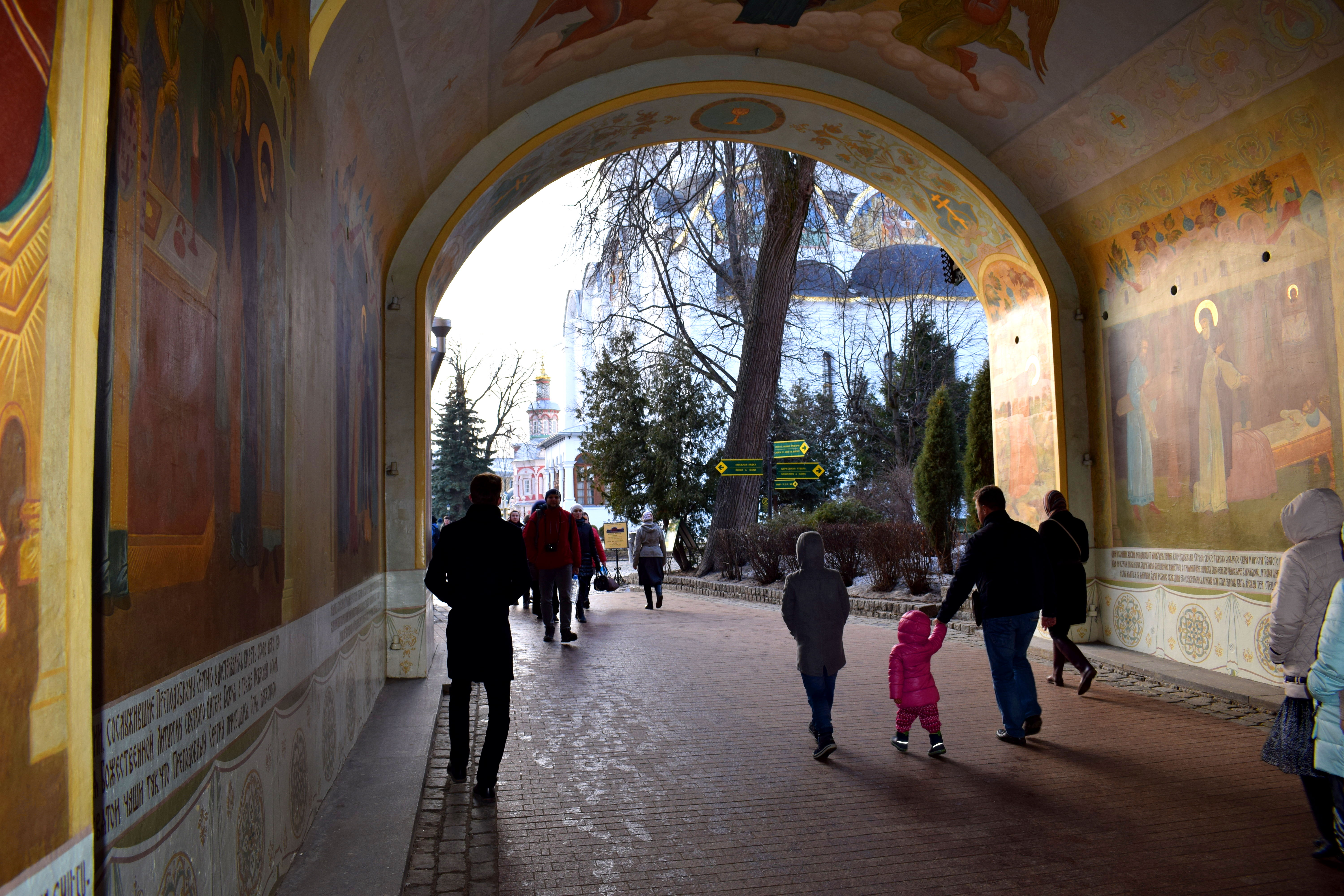 Inside the monastery.
Inside the monastery.
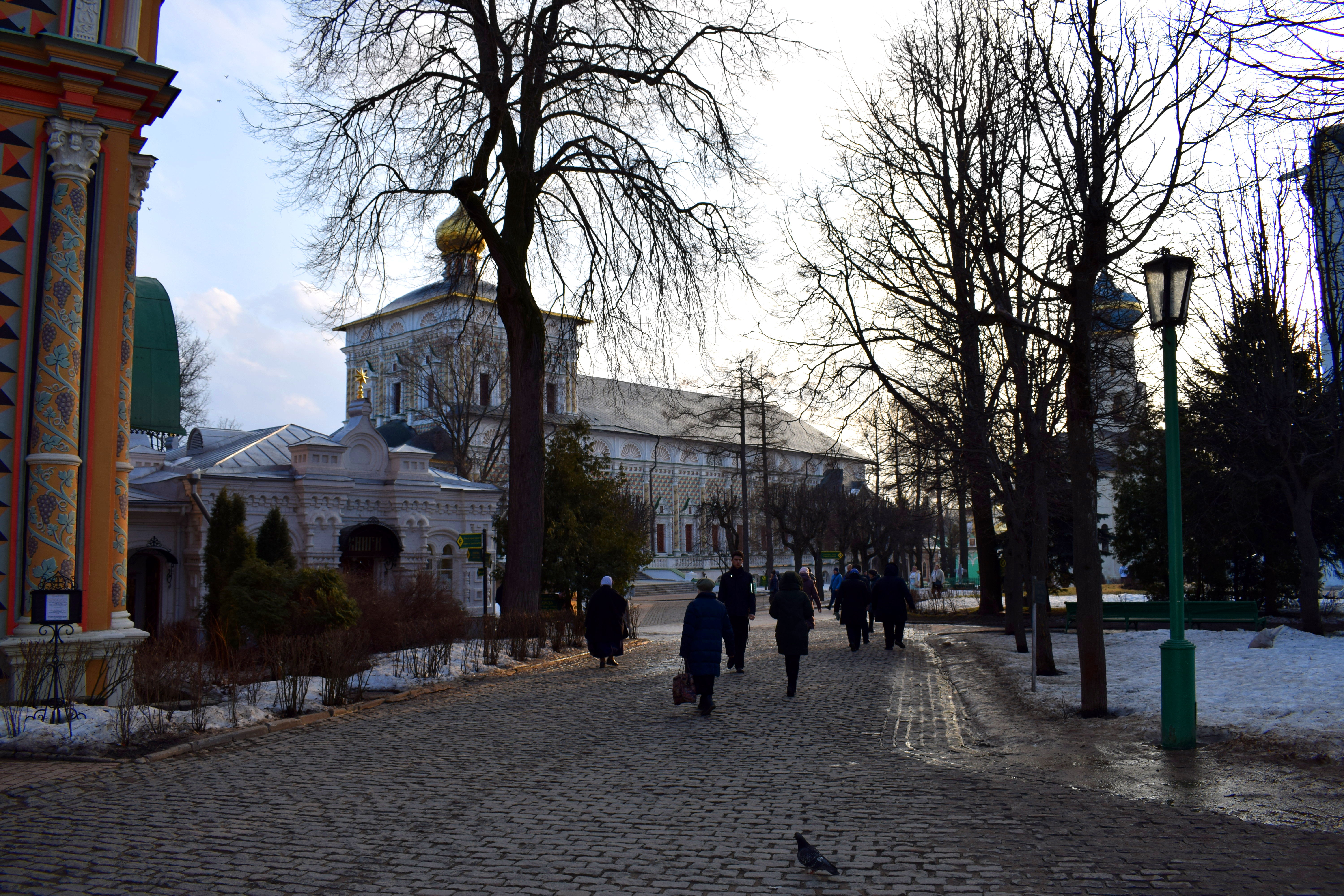
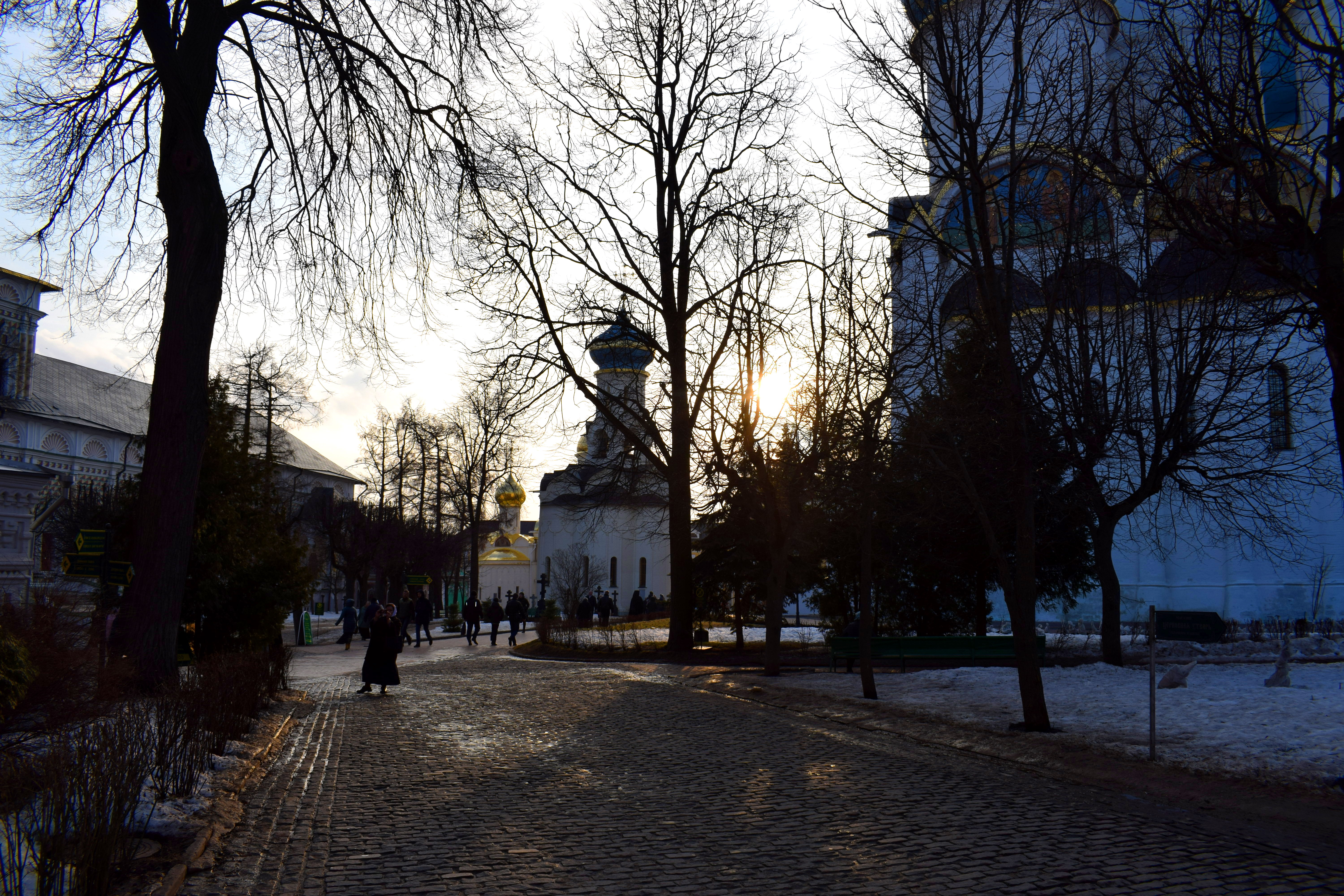
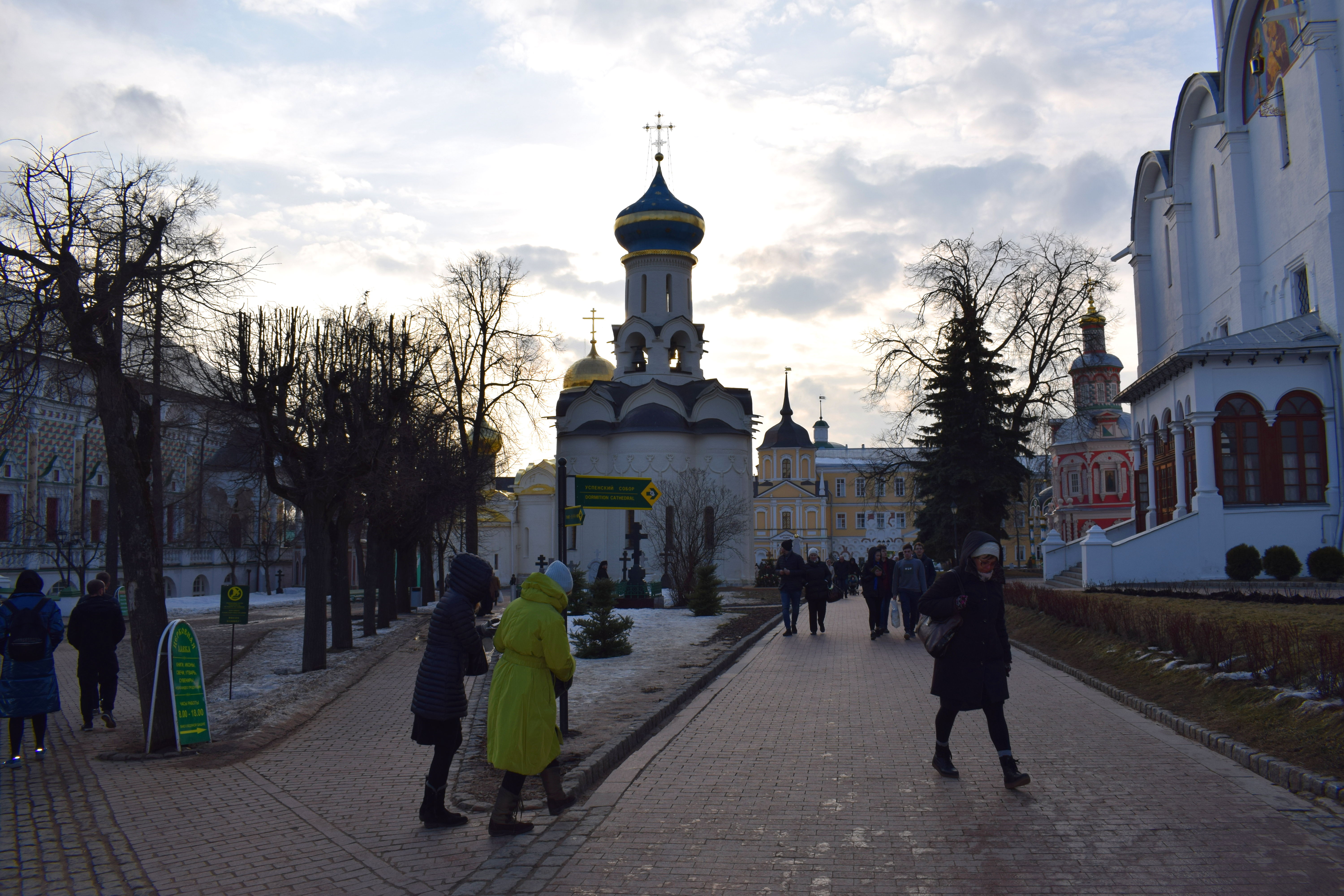 The entrance from the back. The monastery gets hundreds of visitors every day from people all over Russia.
The entrance from the back. The monastery gets hundreds of visitors every day from people all over Russia.
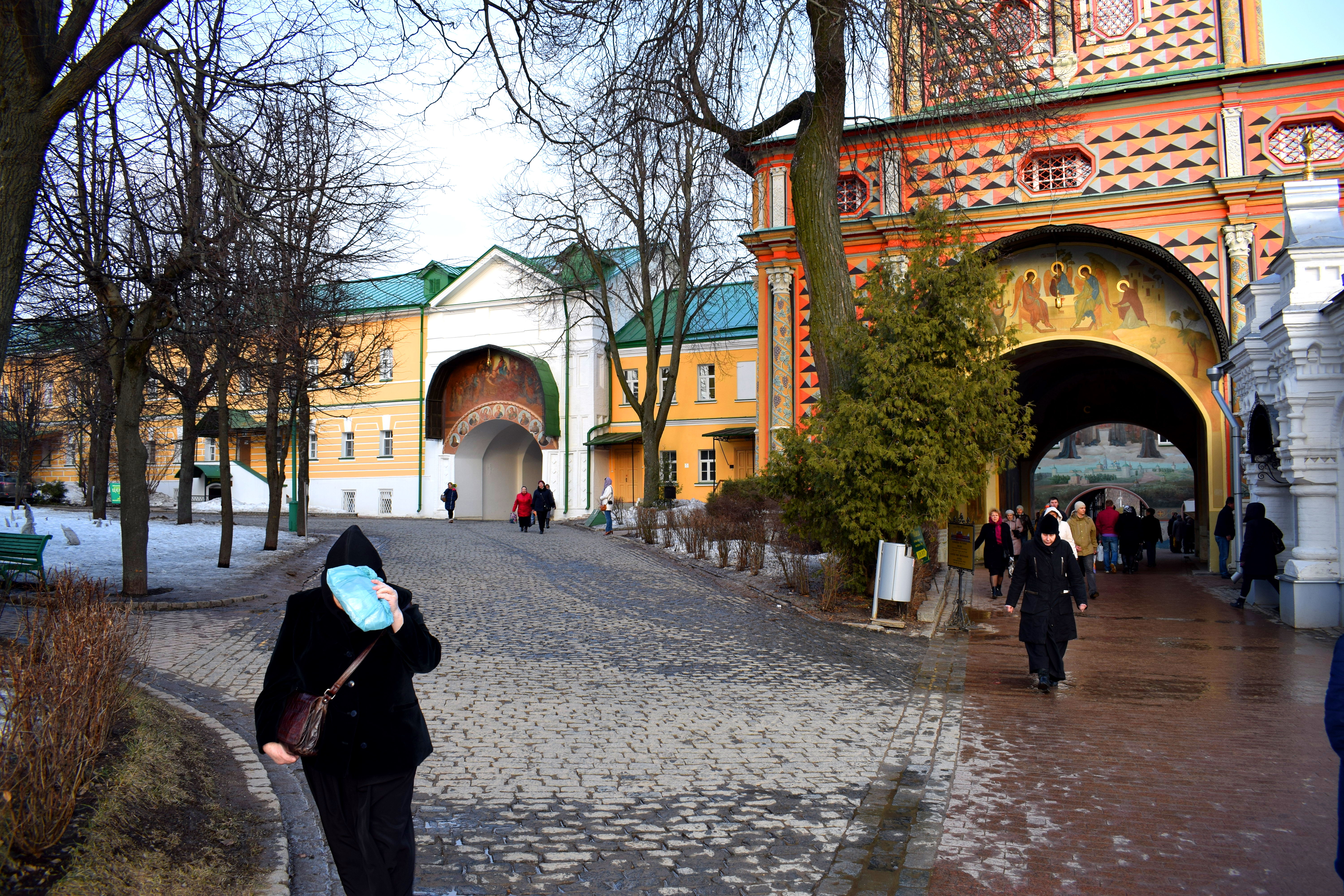 The Predtechensky Church built on top of the entrance to the monastery between 1693-1699.
The Predtechensky Church built on top of the entrance to the monastery between 1693-1699.
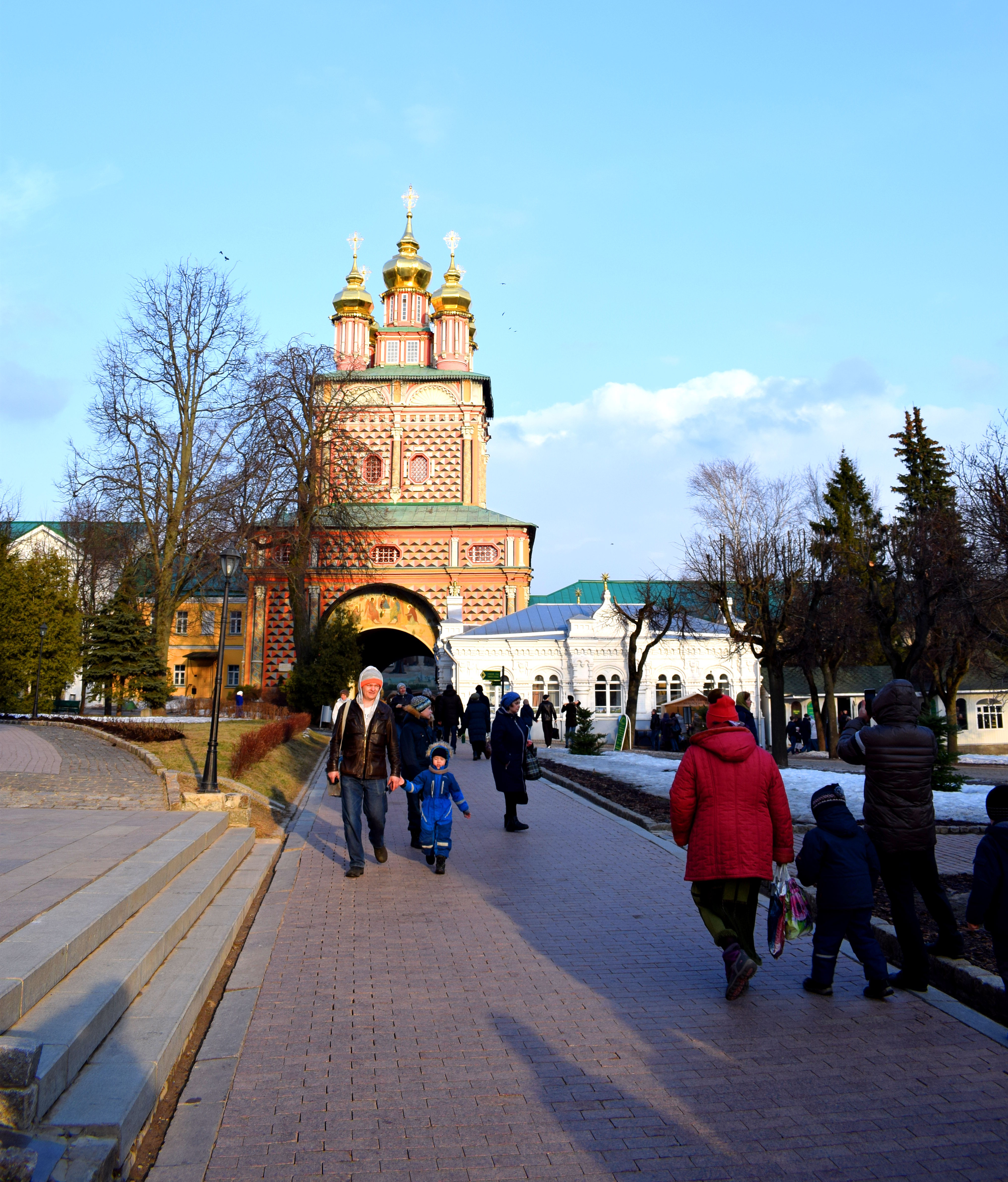 The first stone cathedral in the monastery, the Troitsky Sobor. It was built in 1422 by Serbian monks who had fled to the monastery after the Battle of Kosovo in 1389. The frescoes in the walls were painted by the greatest icon painters in Medieval Russia at the time, Andrei Rublev and Danil Chyorny. Muscovite Royalty was traditionally baptized in the church over the centuries.
The first stone cathedral in the monastery, the Troitsky Sobor. It was built in 1422 by Serbian monks who had fled to the monastery after the Battle of Kosovo in 1389. The frescoes in the walls were painted by the greatest icon painters in Medieval Russia at the time, Andrei Rublev and Danil Chyorny. Muscovite Royalty was traditionally baptized in the church over the centuries.
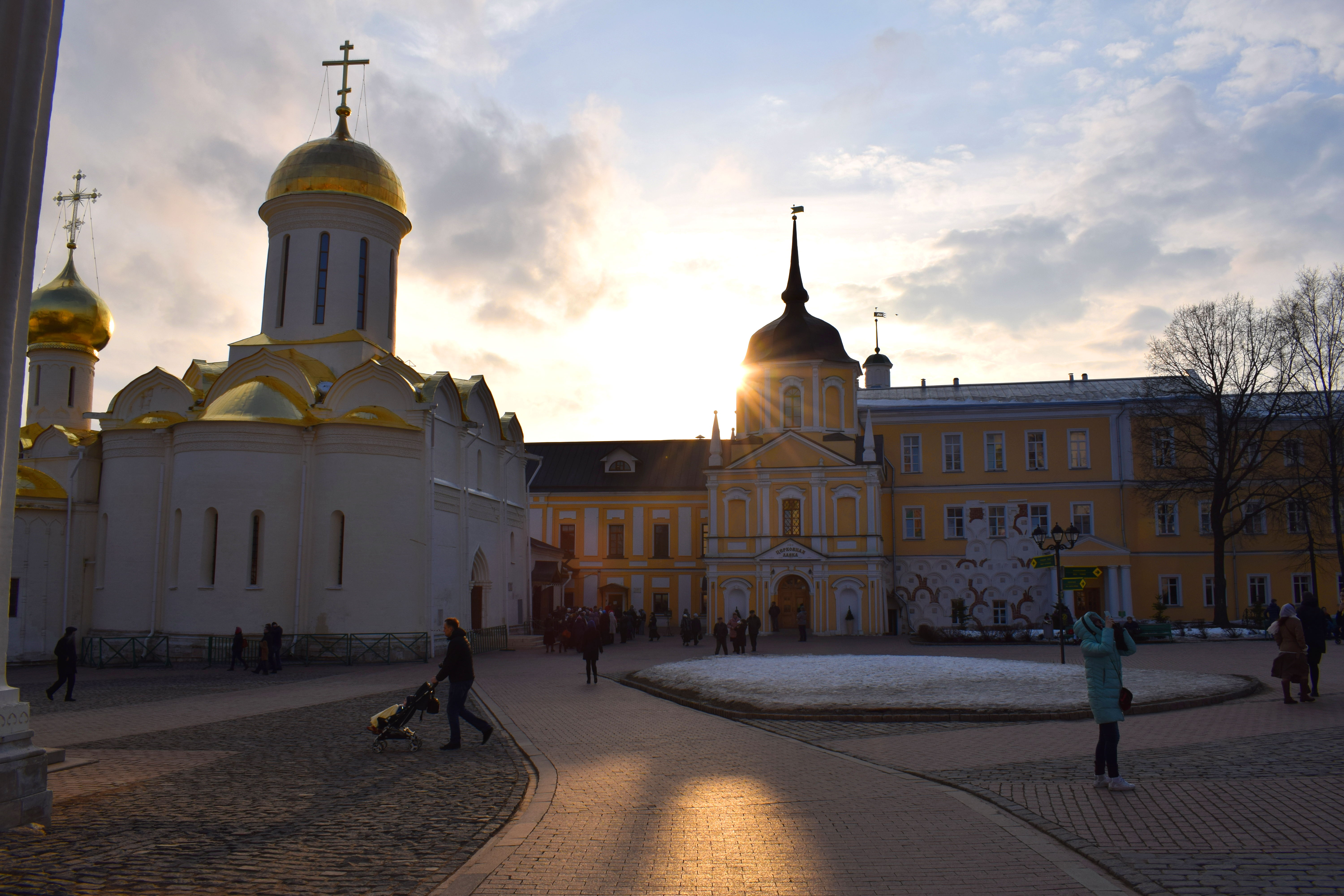 People lining up to enter the church.
People lining up to enter the church.
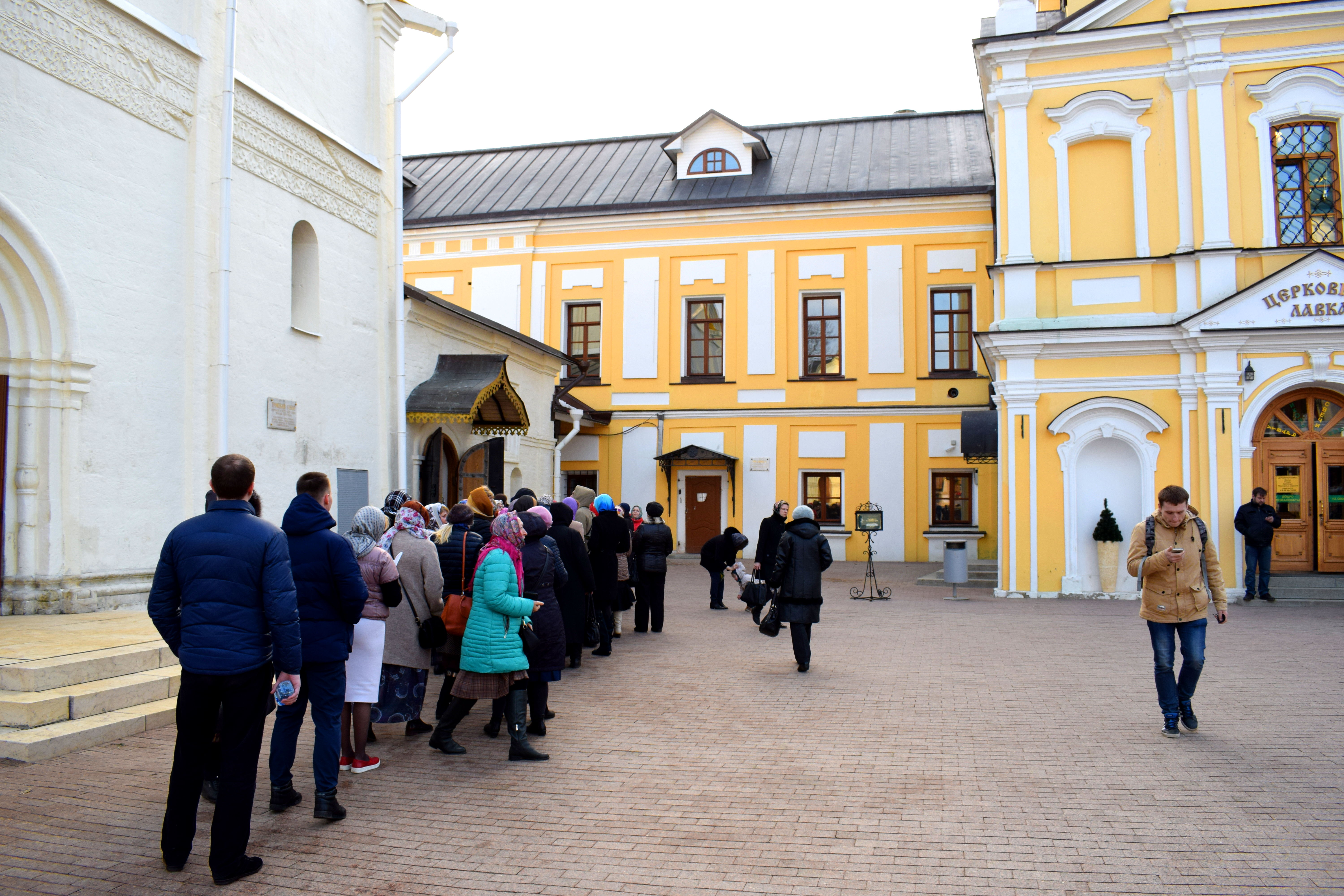
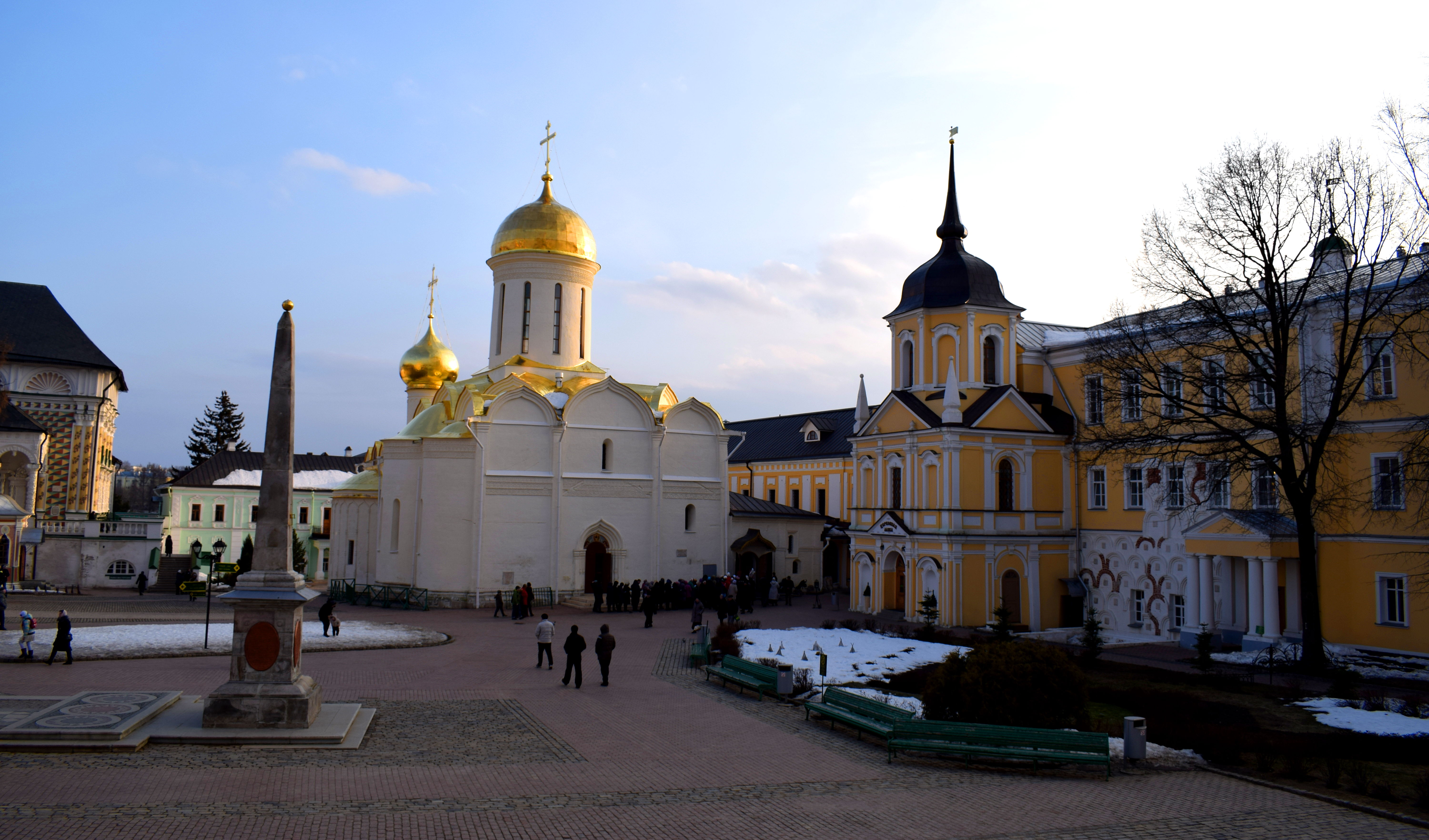 The Sergiev Posad Bell Tower, built between 1741 and 1770. At 88 meters high, it is a fine example of Russian Baroque architecture and at one point had 50 different bells. In 1930 the Bolsheviks destroyed 25 of them, including the largest weighed over 64 tonnes. New bells were added to the tower in 2002-2004.
The Sergiev Posad Bell Tower, built between 1741 and 1770. At 88 meters high, it is a fine example of Russian Baroque architecture and at one point had 50 different bells. In 1930 the Bolsheviks destroyed 25 of them, including the largest weighed over 64 tonnes. New bells were added to the tower in 2002-2004.
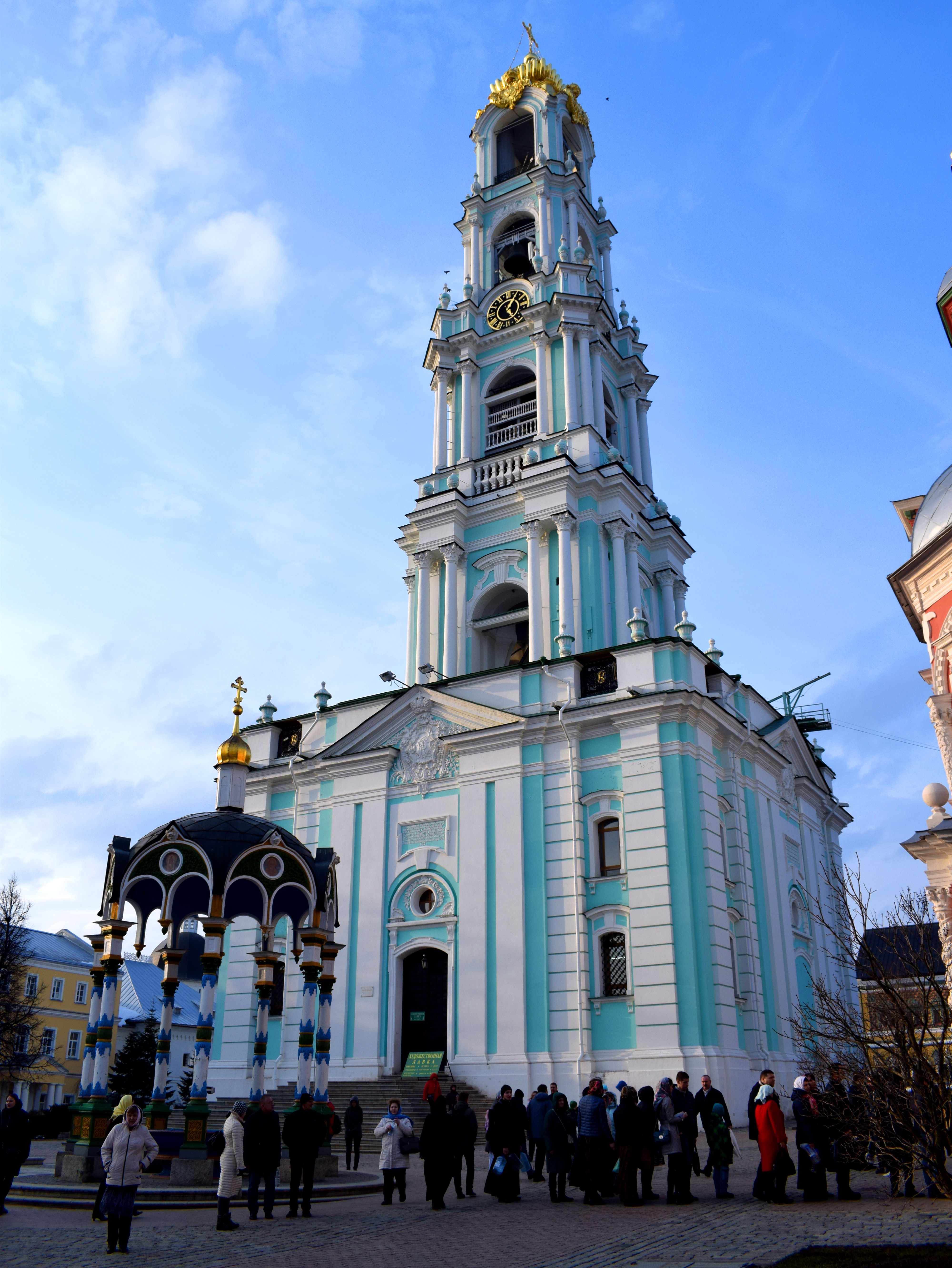 The Uspensky Sobor built in 1585. The church’s layout and design is very similar to the Uspensky Sobor in Moscow’s Kremlin that goes by the same name. The Uspensky Sobor is the biggest church in the monastery. The smaller church in front of the Uspensky Sobor is called the ‘Chapel Over the Well’ church. It was built later in 1700.
The Uspensky Sobor built in 1585. The church’s layout and design is very similar to the Uspensky Sobor in Moscow’s Kremlin that goes by the same name. The Uspensky Sobor is the biggest church in the monastery. The smaller church in front of the Uspensky Sobor is called the ‘Chapel Over the Well’ church. It was built later in 1700.
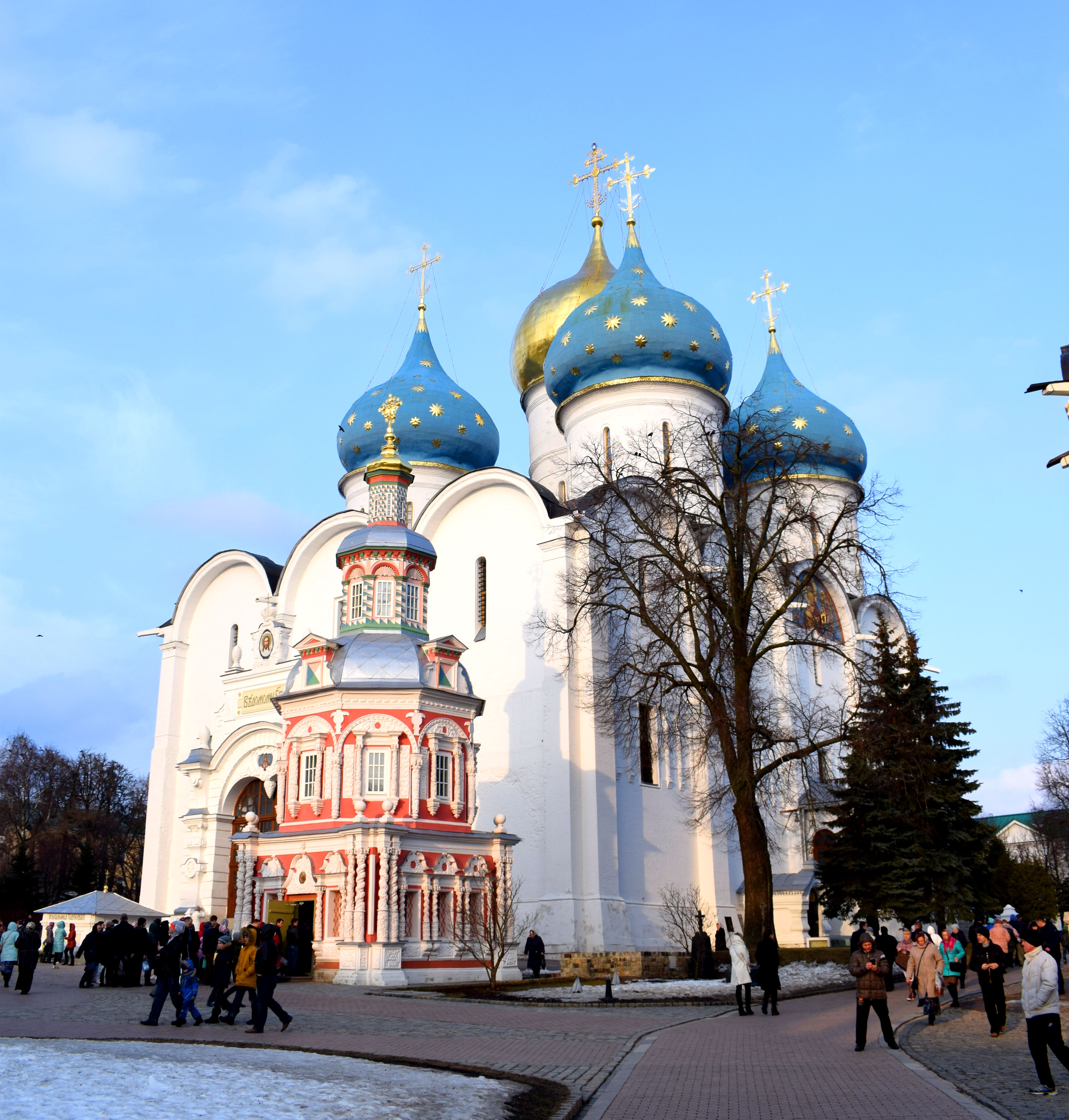 The Uspensky Sobor and the Chapel Over the Well Church on the left and on the right is a church named after the descent of the Holy Spirit on the Apostles, built in 1476.
The Uspensky Sobor and the Chapel Over the Well Church on the left and on the right is a church named after the descent of the Holy Spirit on the Apostles, built in 1476.
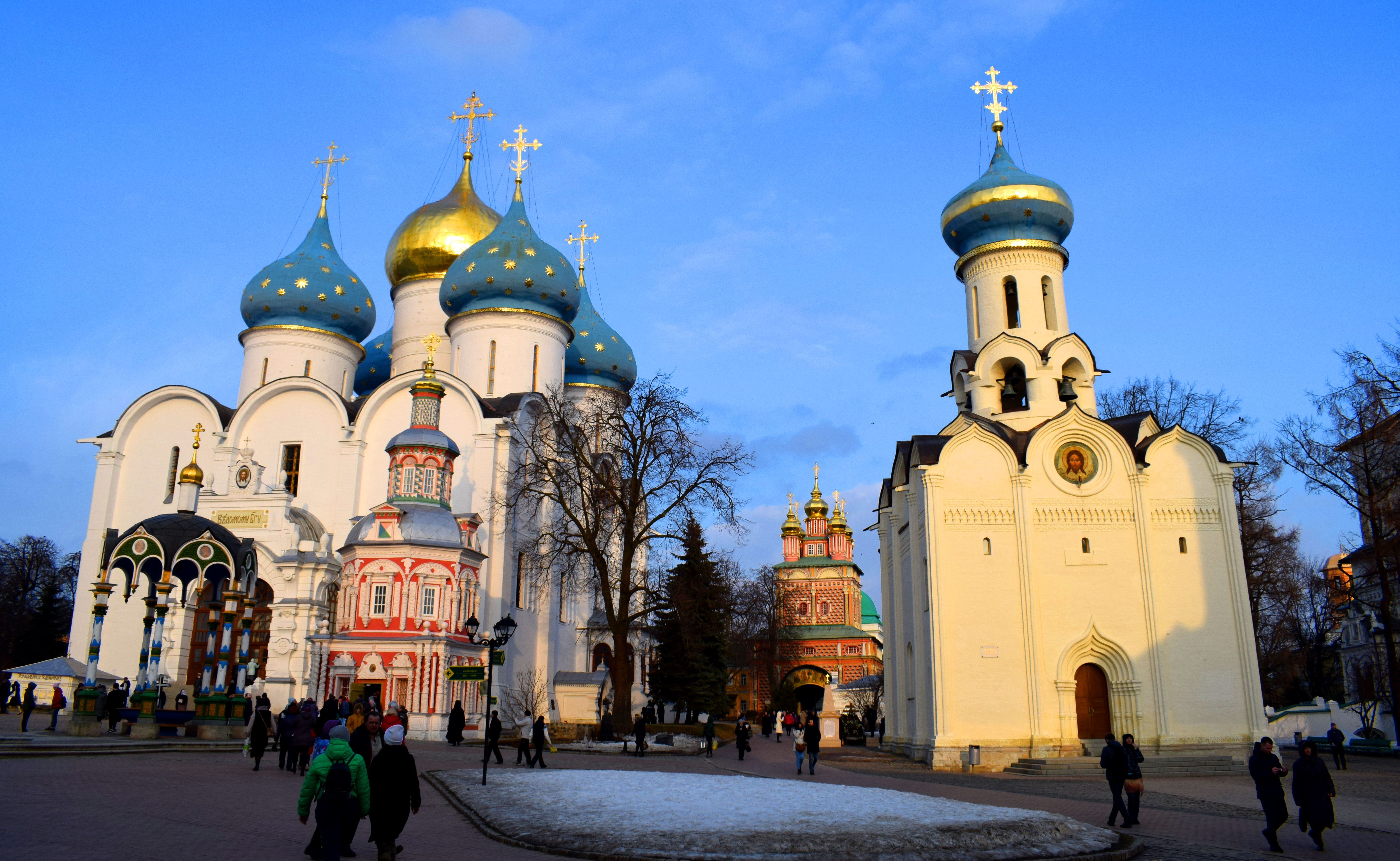 People lining up to enter the Chapel Over The Well Church.
People lining up to enter the Chapel Over The Well Church.
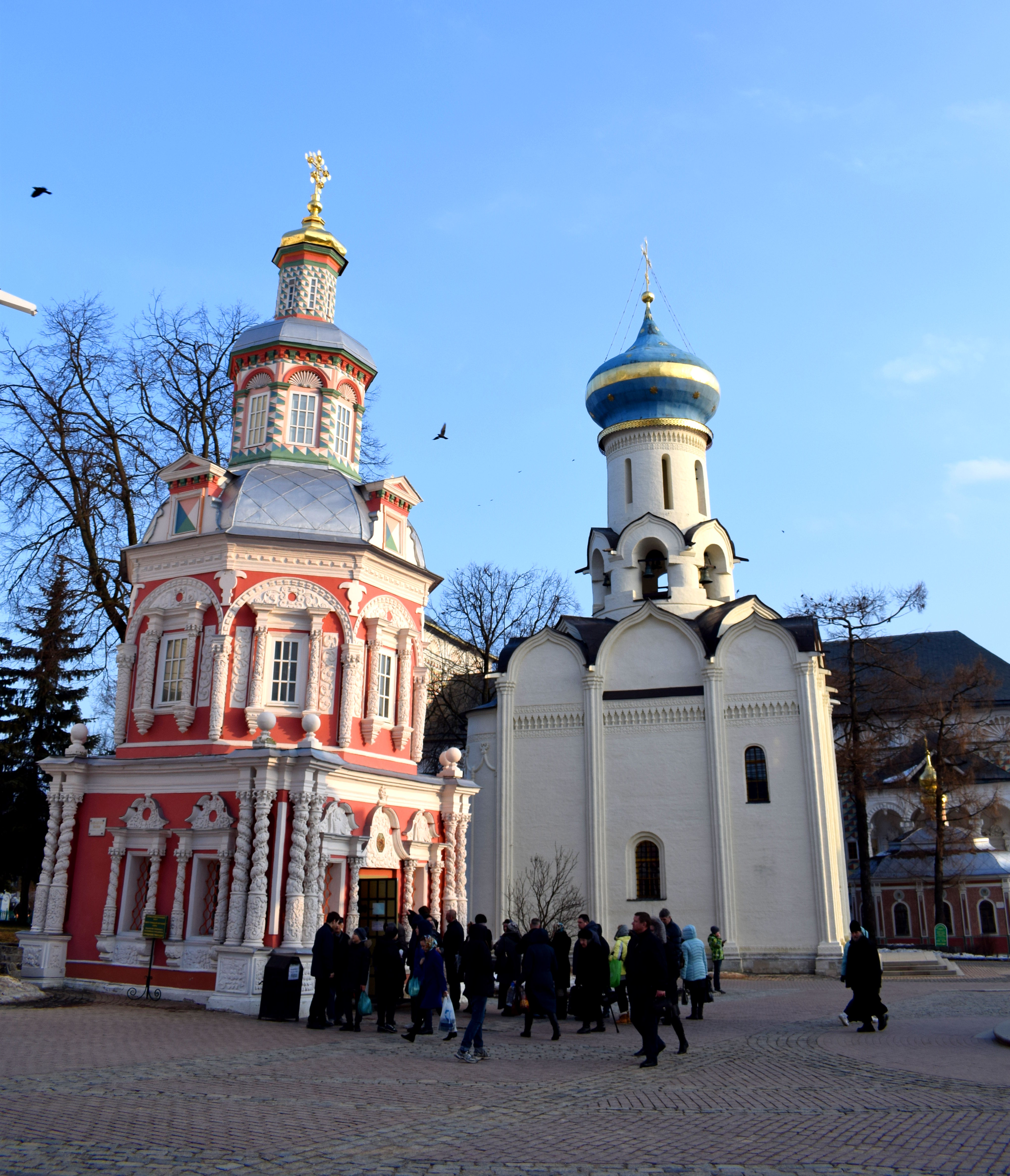 More buildings in the monastery.
More buildings in the monastery.
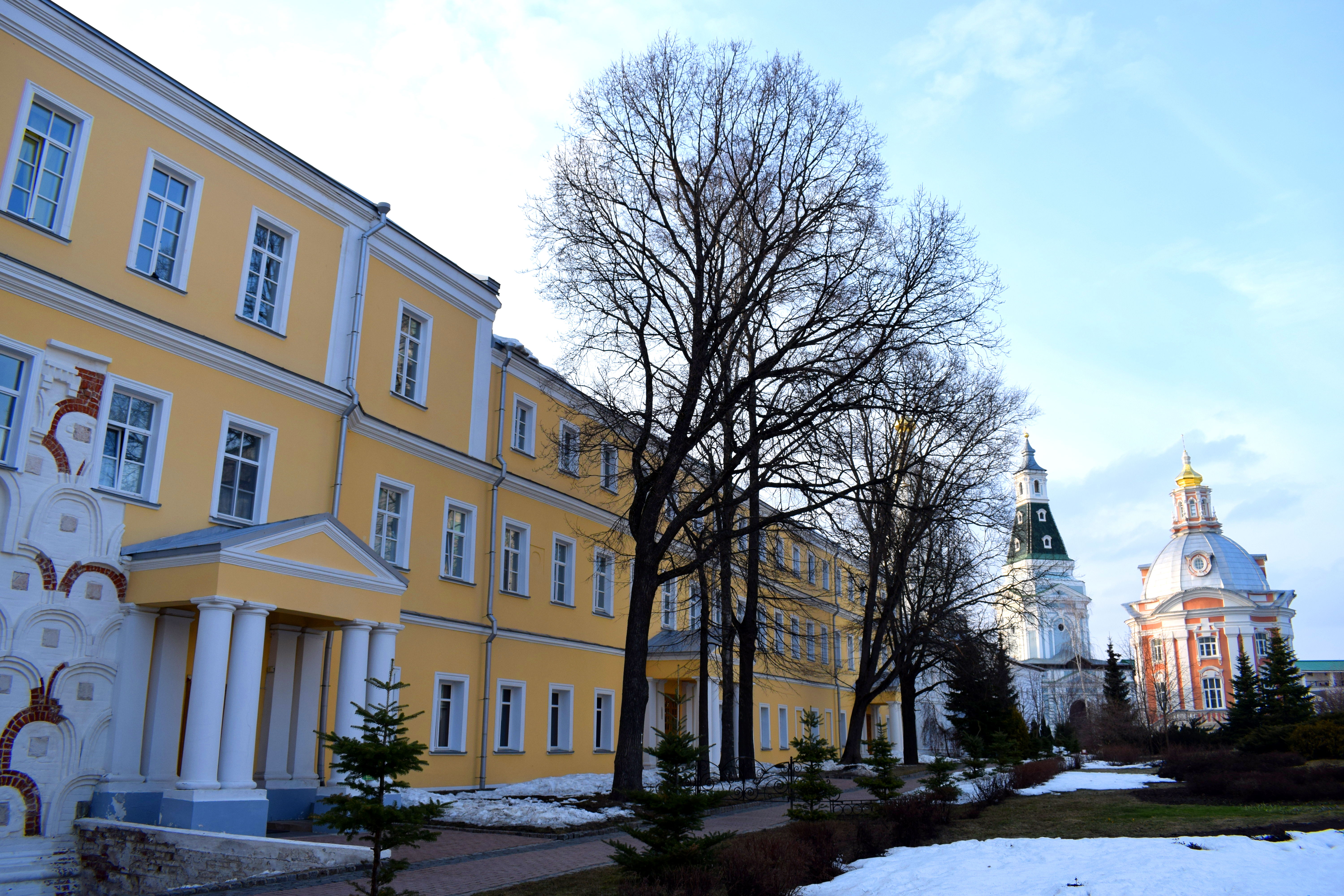
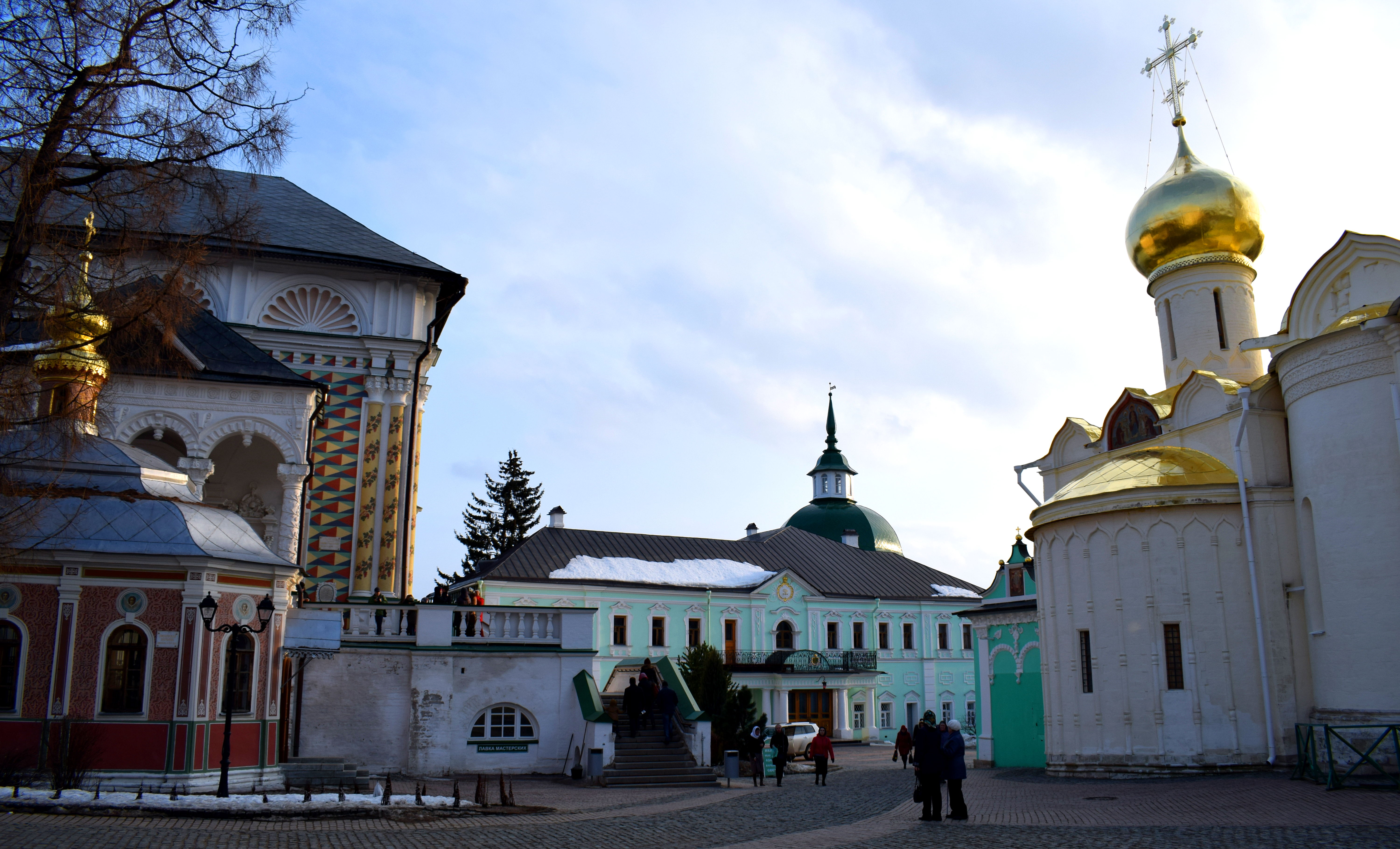
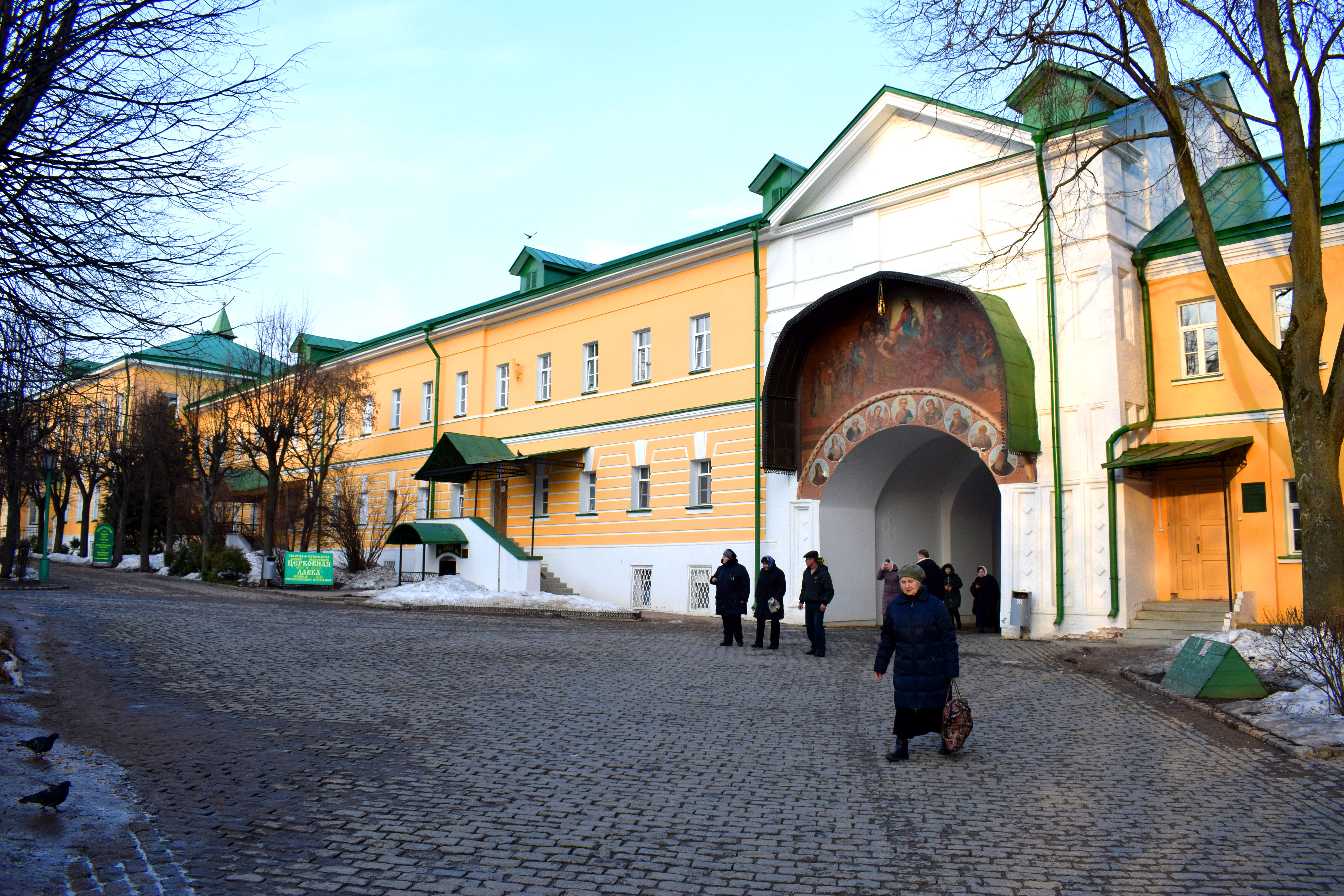 Exiting the monastery.
Exiting the monastery.
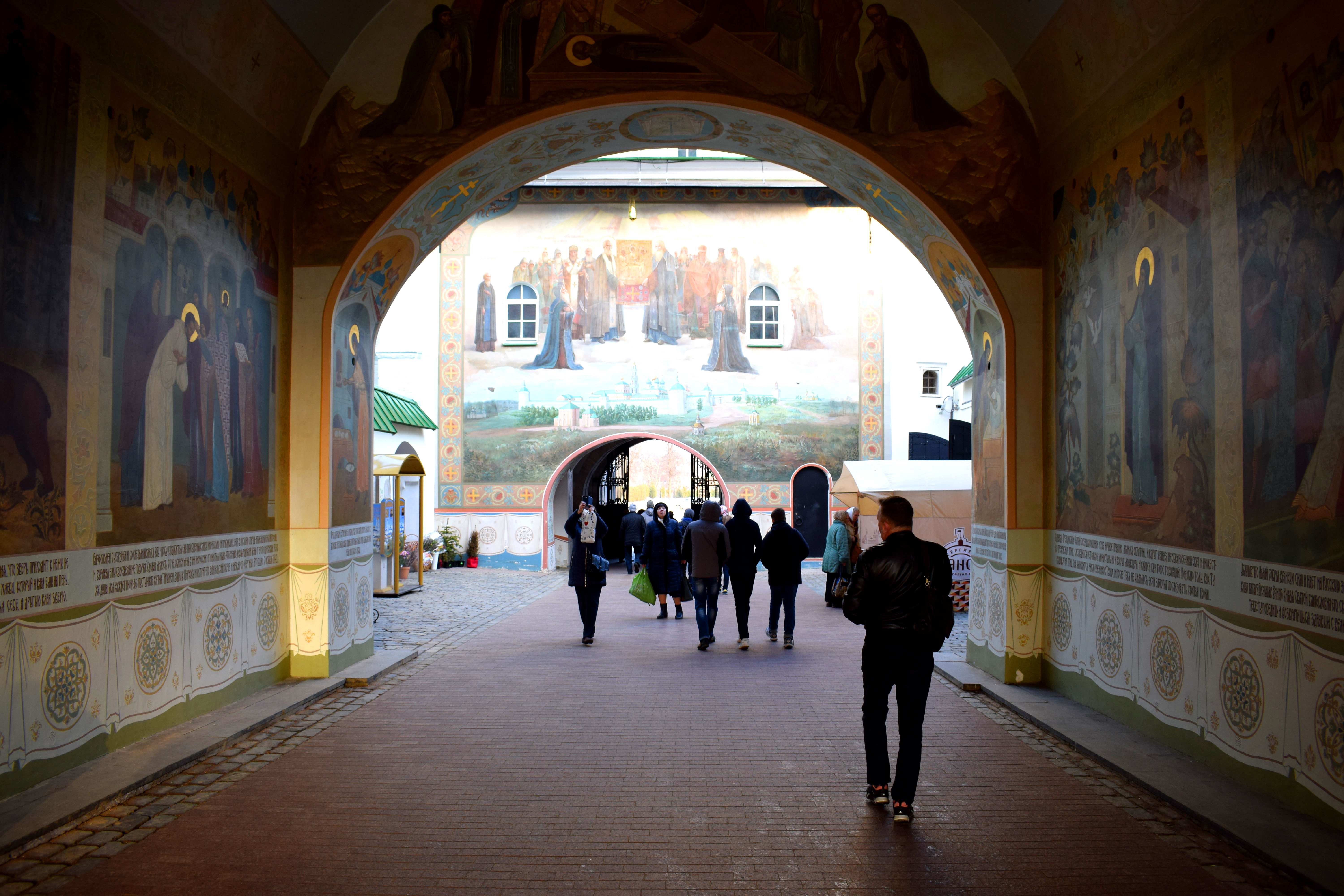 Back outside near the walls.
Back outside near the walls.
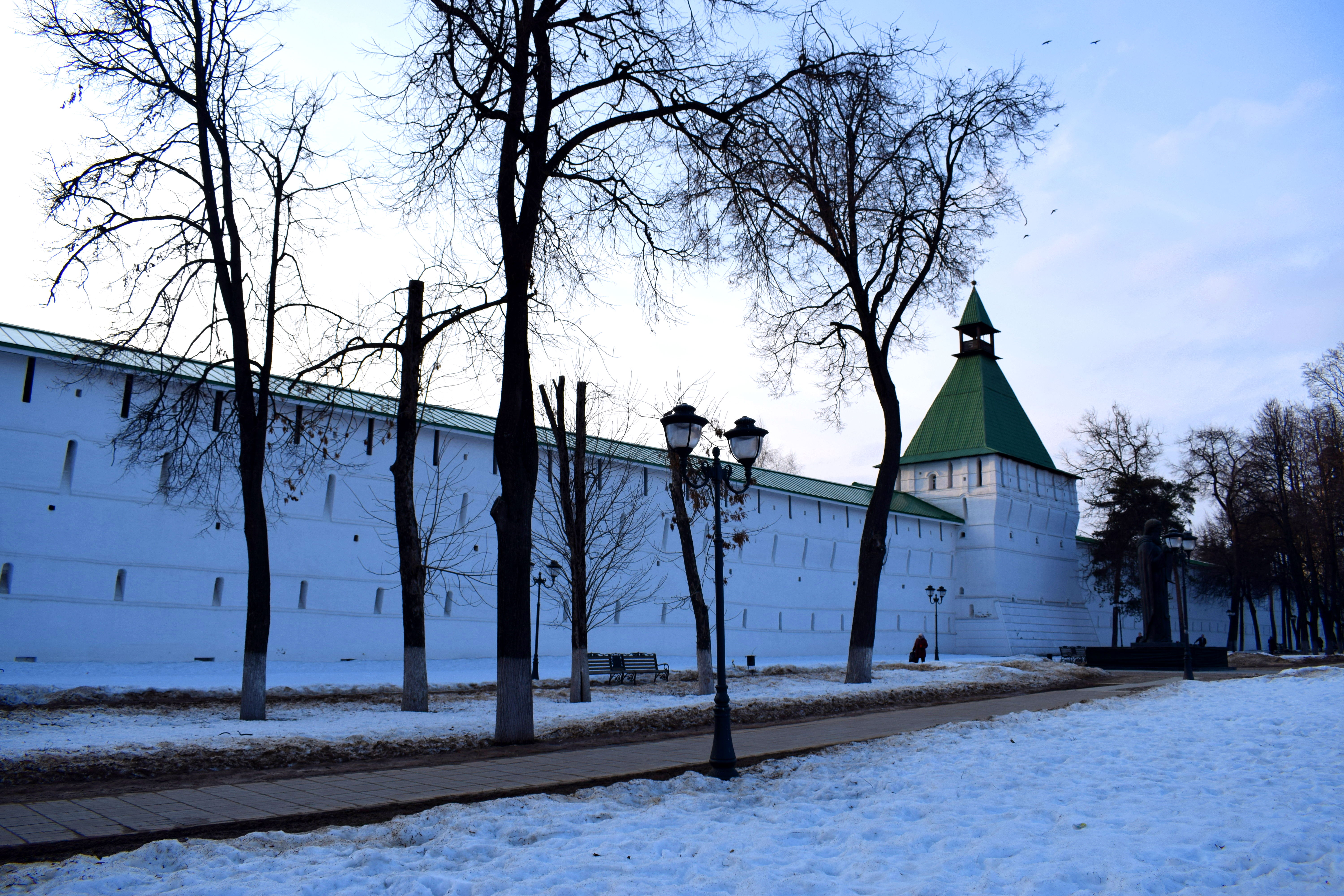 The square in front of the monastery. In the early 20th century the area square was filled with traders and shopkeepers who sold their goods and services to locals. The Soviet Union closed down the shops in the latter half of the 20th century because it viewed them as engaging in ‘profiteering’ which was against the Soviet Union’s communist ideology.
The square in front of the monastery. In the early 20th century the area square was filled with traders and shopkeepers who sold their goods and services to locals. The Soviet Union closed down the shops in the latter half of the 20th century because it viewed them as engaging in ‘profiteering’ which was against the Soviet Union’s communist ideology.
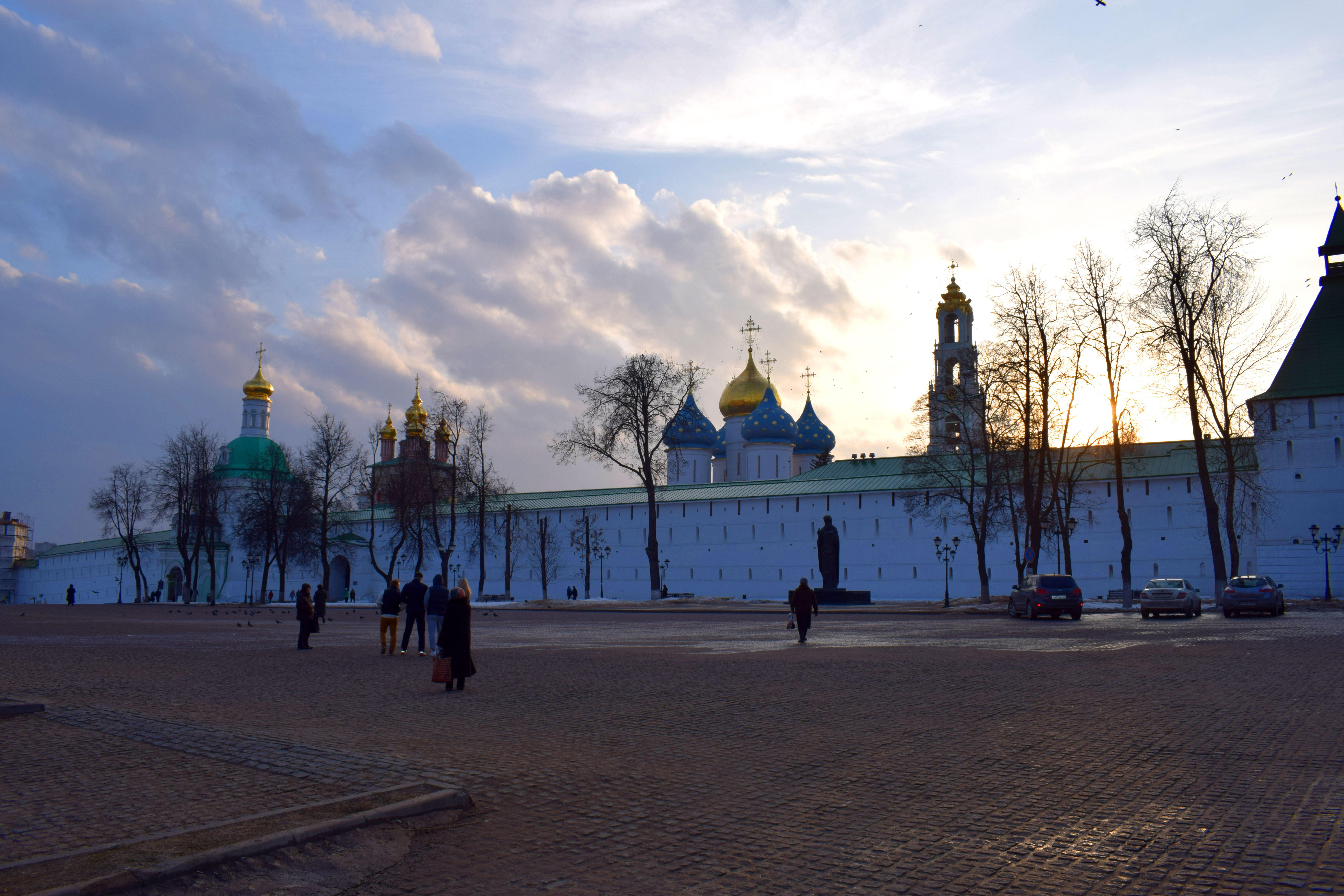 Beside the monastery is a beautiful park with several historical buildings, including the Old Monastery Inn built in the neoclassical style in 1825 and partially rebuilt in the same style after a fire in 1838. After the 1917 revolution the building was nationalized and became the property of the state. In 2000 it was returned to the monastery and renovated in 2005-2007.
Beside the monastery is a beautiful park with several historical buildings, including the Old Monastery Inn built in the neoclassical style in 1825 and partially rebuilt in the same style after a fire in 1838. After the 1917 revolution the building was nationalized and became the property of the state. In 2000 it was returned to the monastery and renovated in 2005-2007.
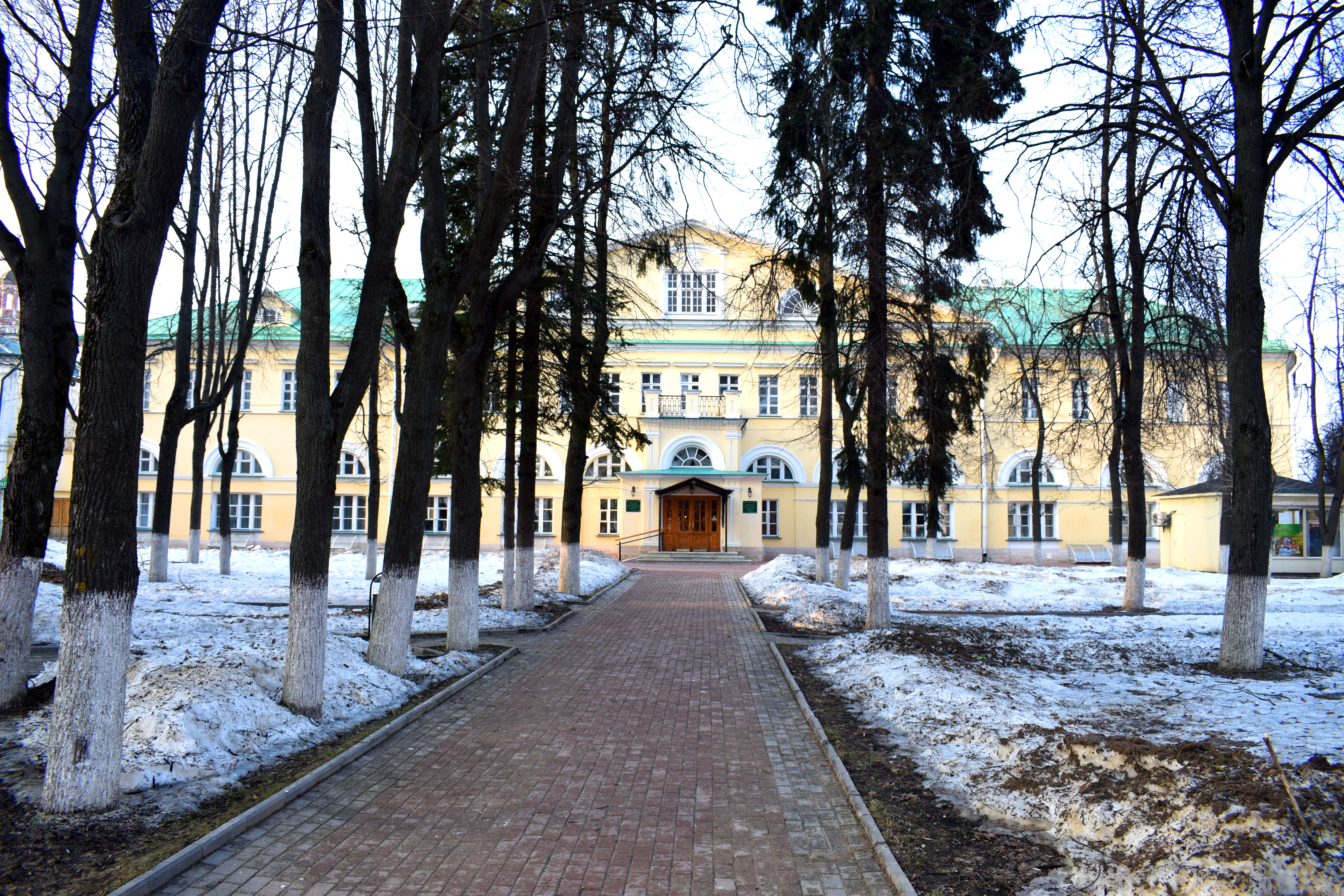 Sergiev Posad also has its fair share of historical buildings. The main street in Sergiev Posad is Red Army Prospect which runs parallel to the monastery. These buildings were built in the 1880’s. At the start of the 20th century the yellow building on the corner hosted Sergiev Posad’s women’s gymnasium.
Sergiev Posad also has its fair share of historical buildings. The main street in Sergiev Posad is Red Army Prospect which runs parallel to the monastery. These buildings were built in the 1880’s. At the start of the 20th century the yellow building on the corner hosted Sergiev Posad’s women’s gymnasium.
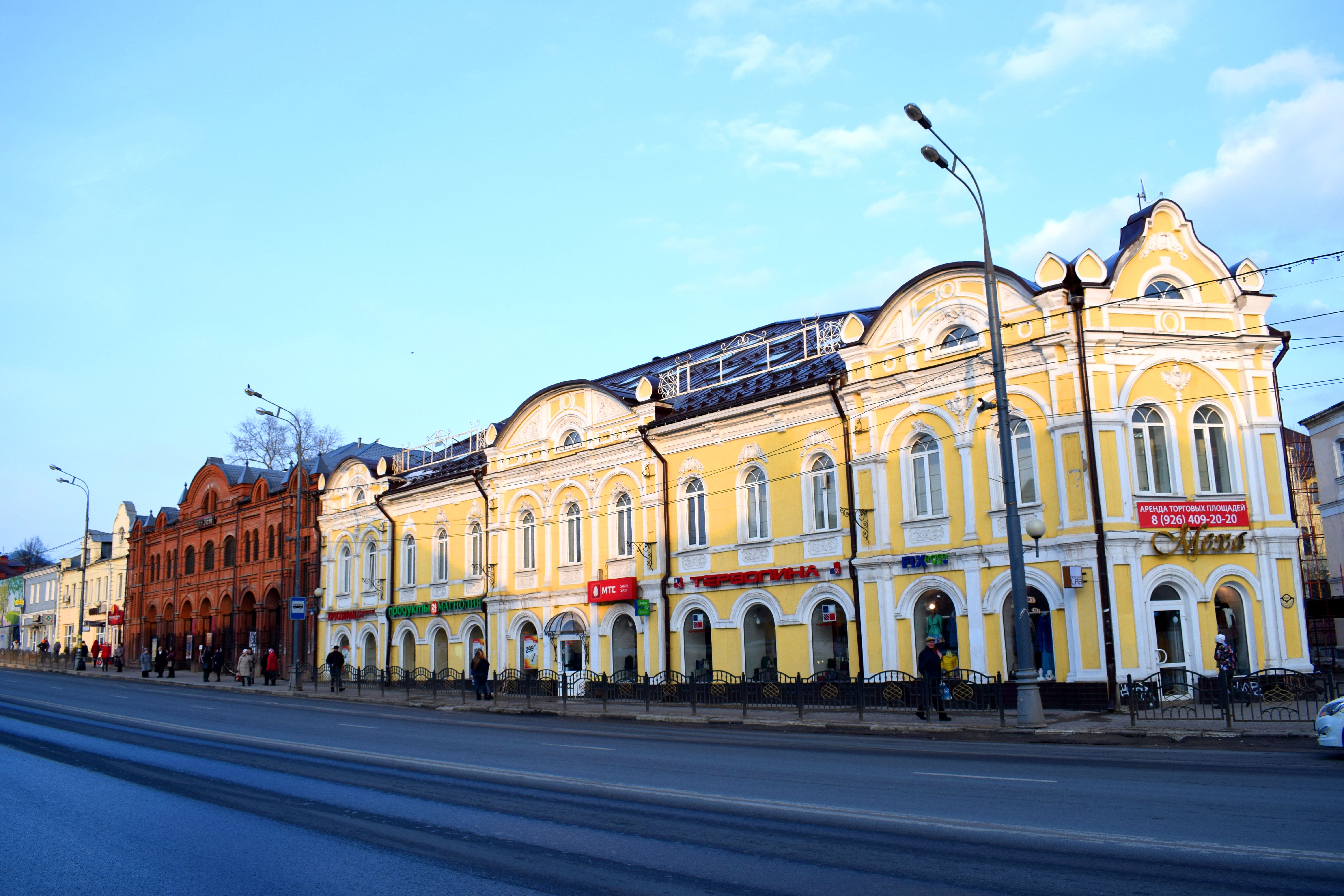 Sergiev Posad’s Museum of History and Art.
Sergiev Posad’s Museum of History and Art.
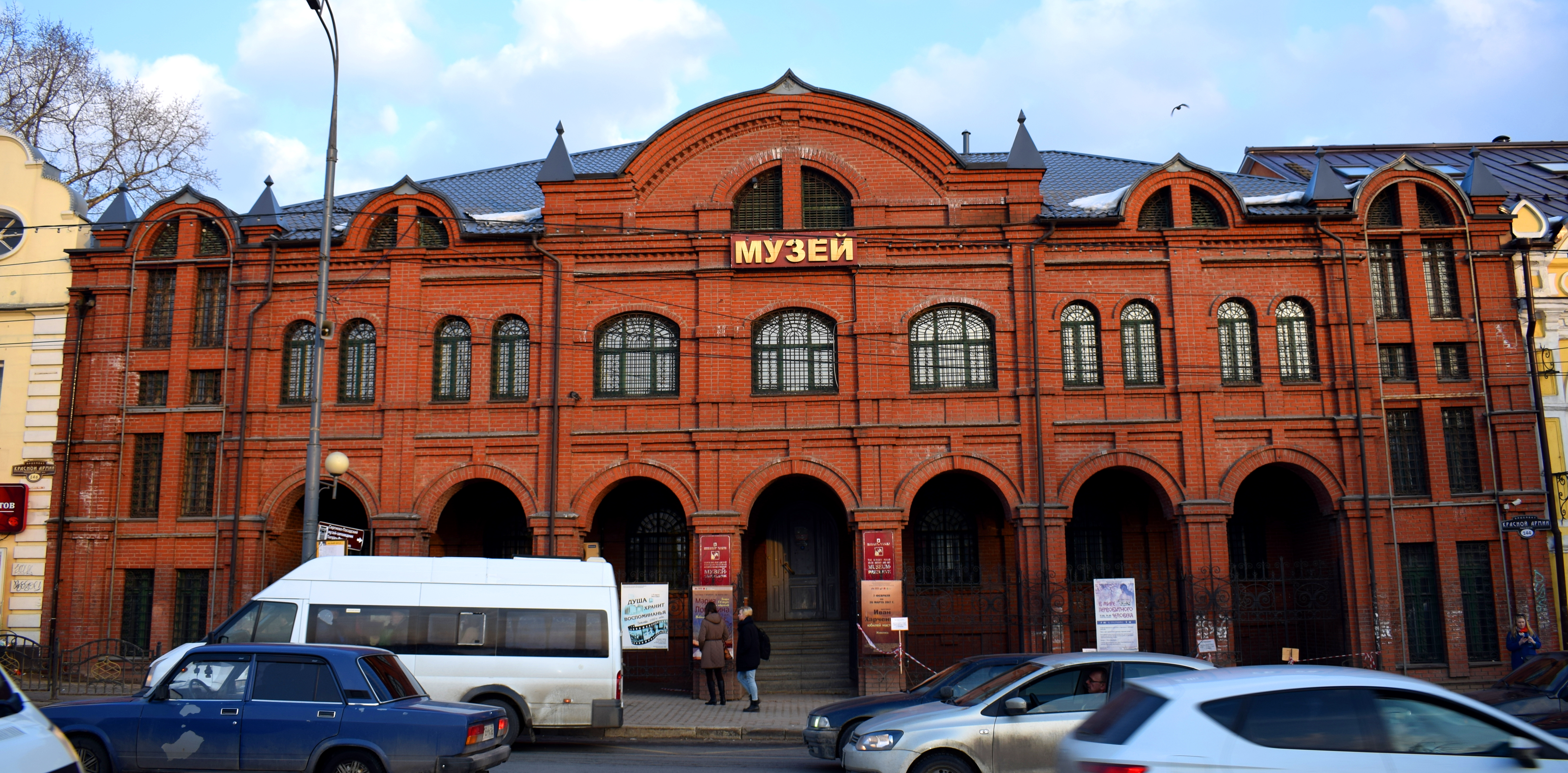 The park outside the monastery.
The park outside the monastery.
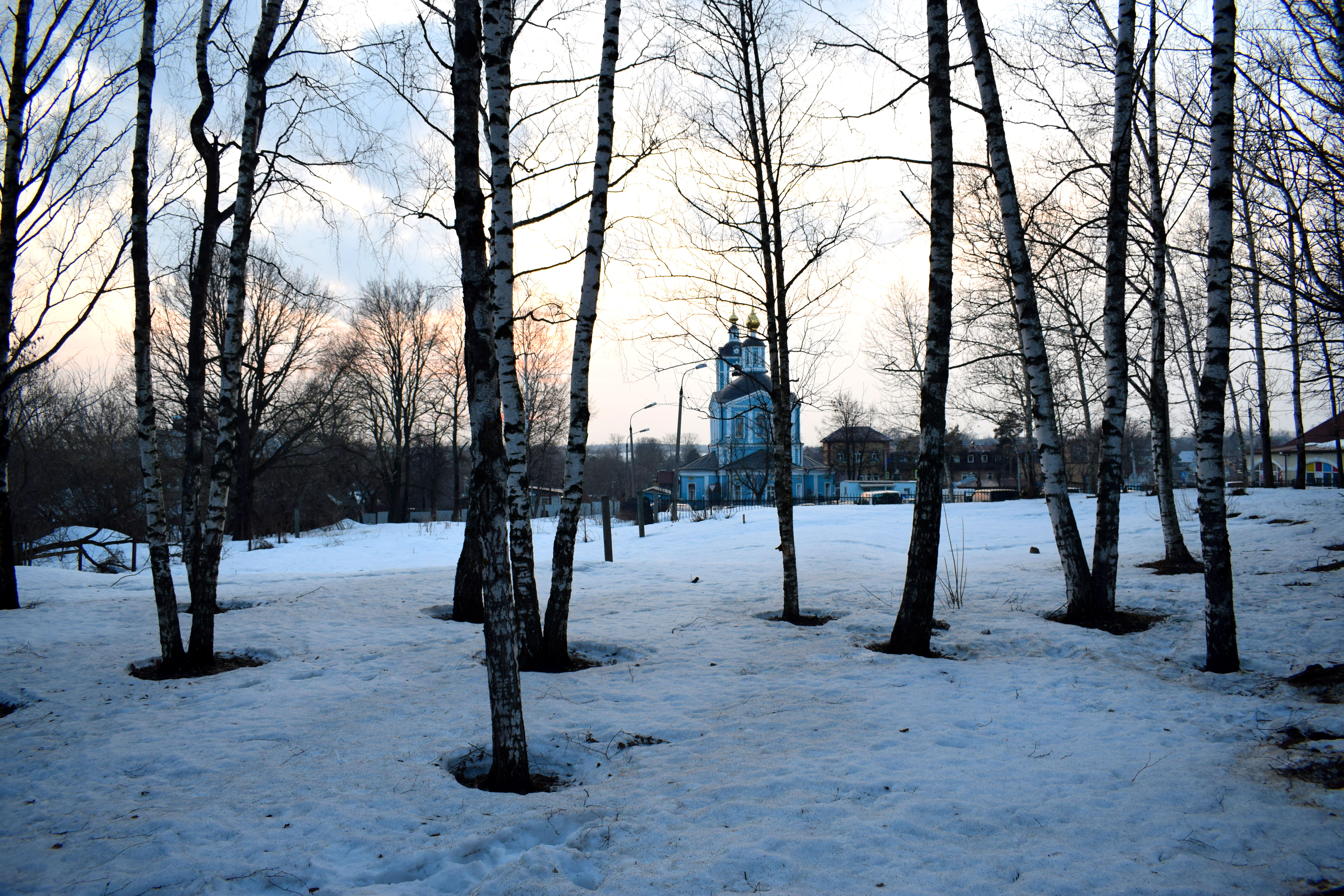 The Y. Gagarin Palace of Culture, built in 1954 and an example of Soviet neoclassical architecture.
The Y. Gagarin Palace of Culture, built in 1954 and an example of Soviet neoclassical architecture.
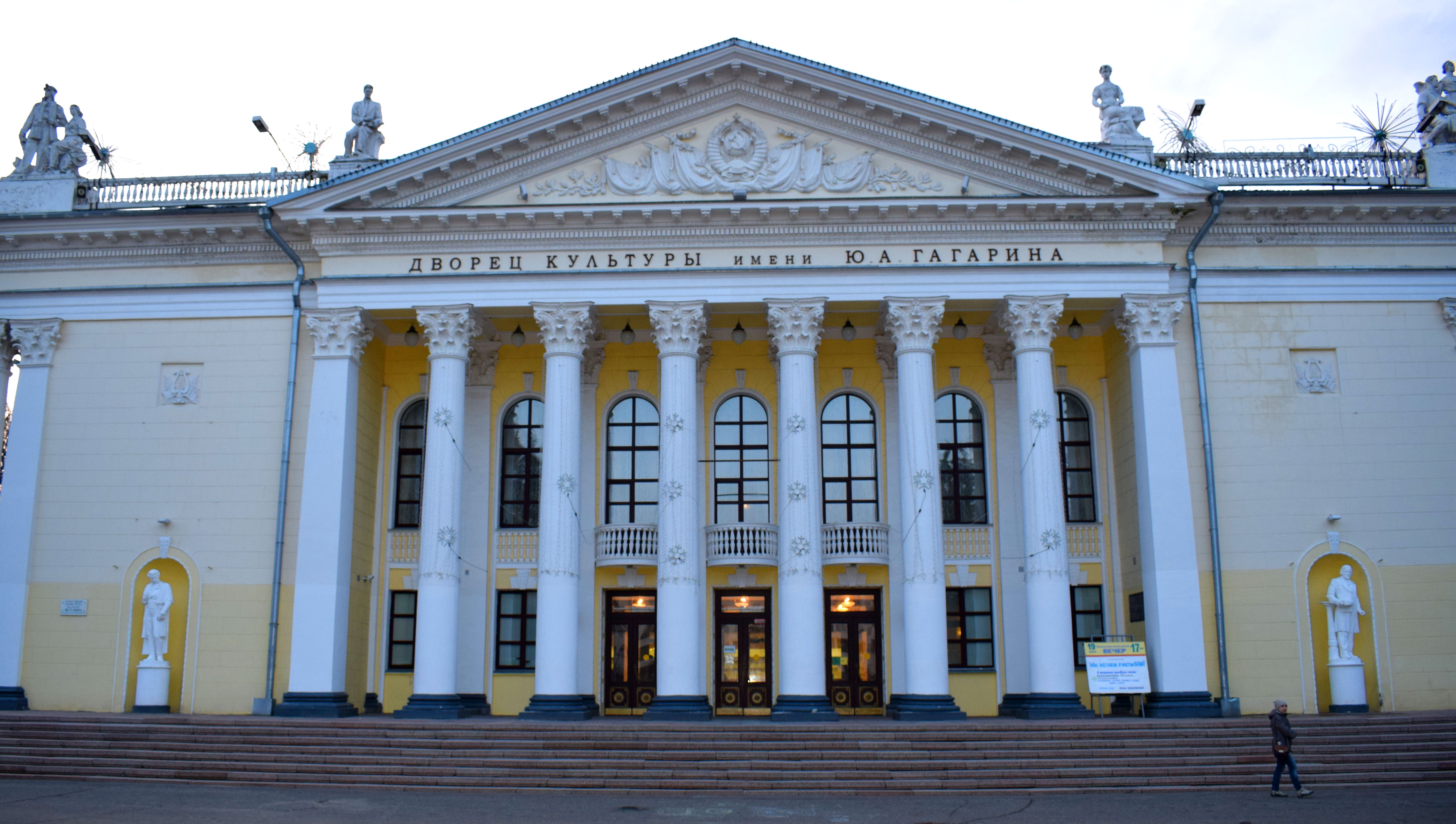 Some old buildings on our way back to the train station.
Some old buildings on our way back to the train station.
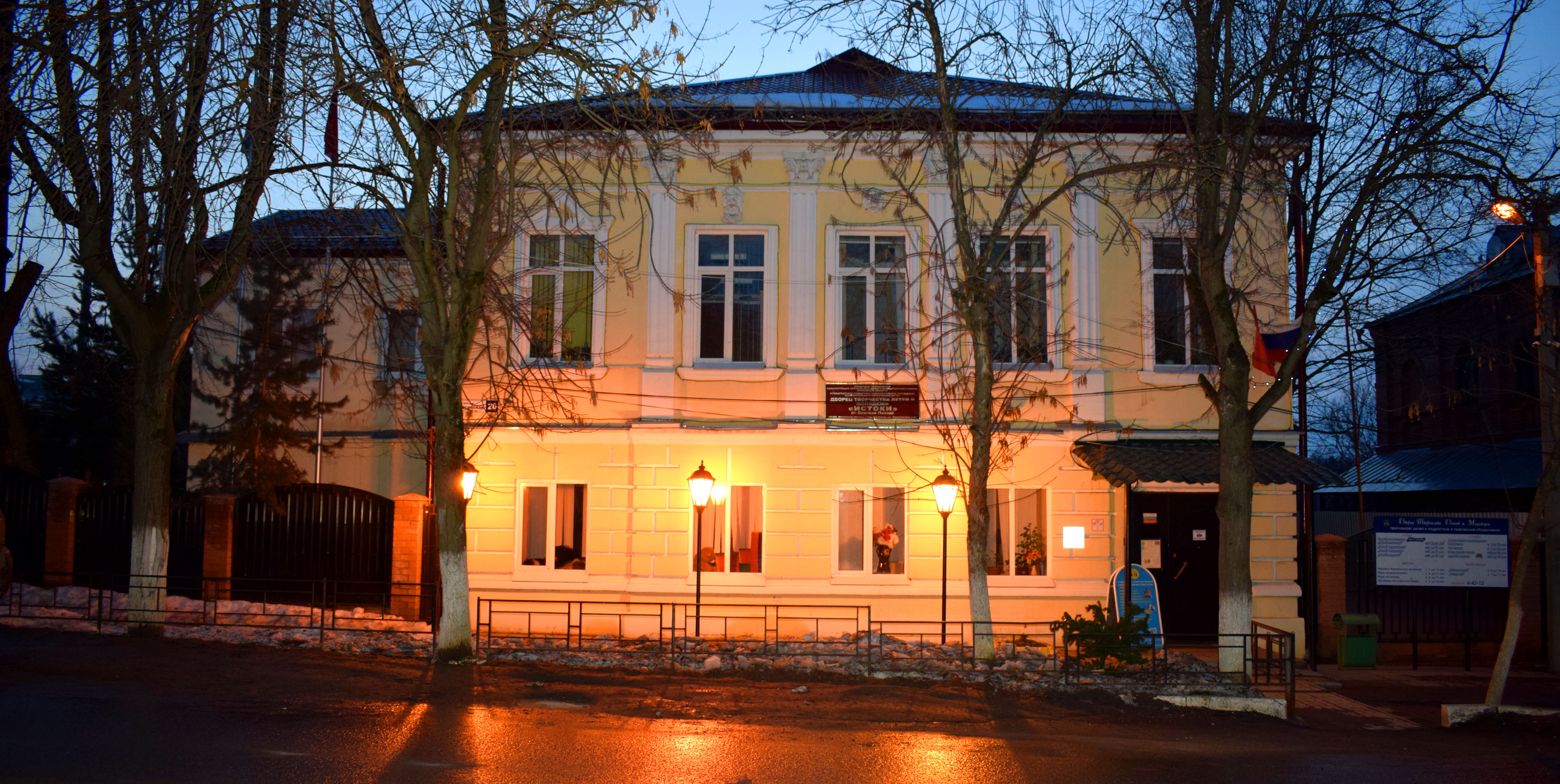 Before catching the train we decided to stop by a local store to buy our favorite Russian beer ‘Mohnaty Shmel’, which translates into English as ‘furry bumblebee’. The beer is named after a famous Soviet song and it is by far the best Russian beer I have found so far. Highly recommend trying it.
Before catching the train we decided to stop by a local store to buy our favorite Russian beer ‘Mohnaty Shmel’, which translates into English as ‘furry bumblebee’. The beer is named after a famous Soviet song and it is by far the best Russian beer I have found so far. Highly recommend trying it.
